ENVIS Centre, Ministry of Environment & Forest, Govt. of India
Printed Date: Sunday, September 14, 2025
Medicinal Plants
MEDICINAL PLANT
Abroma augusta (L) Lt. (Sterculiaceae)
(now known as Ambroma L. f.)
.jpg)
Syn : Abroma augulata Lam., A. wheeleri Retz., A. fastuosum Gaertn., Theobroma augusta L.
English name: Devil's cotton.
Vernacular names: Asm : Bon kopashi; Hin and Ben: Ulat kambal; Tam: Sivapputtutti.
Trade name: Ulat kambal.
Traditional use: Seed: yields fatty oil, rich in linoleic acid and lowers cholesterol level in blood.
HOMOEOPATHY : used to control mind, different ailments of head, heart, eyes, ears, nose, face, mouth, throat, stomach, abdomen, urinary organs, male and female sexual organs, respiratory organs, neck, back and limbs, skin diseases, fever; to regulate appetite and sleep.
Modern use: Fresh and dried root-bark: used as uterine tonic and emmenagogue; regulates menstrual flow; Fresh juice from root- bark: useful in congestive and neuralgic forms of dysmenorrhoea, amenorrhoea, urinary trouble, bronchitis, broncho-pneumonia, carbuncles and poisonous boils; Leaf: used in diabetes, rheumatic pain and sinusitis.
Phytography : Shrub, branches downy; leaf simple, cordate, 10-15 cm by 10-12.5 cm, base 3-7 costate, repand-denticulate while the upper narrower leaves are entire, glabrescent above and tomentose below, petiolate, petioles 1.25-2.5 cm long, stipules linear, as long as the petiole, deciduous; flowers axillary, pedunculate, peduncle 3.5 cm long; capsules 5-angled, 5-winged, obpyramidal, thrice as long as the persistent calyx; seeds albuminous, numerous.
Distribution: Widely distributed in hotter parts of India up to 1500 m; Bangladesh, Pakistan and the adjacent countries.
Ecology and cultivation: Plant prefers hot and moist climate; sometimes planted, occasionally found as an escape.
Chemical contents: Plant: fixed oil, a little resinous matter, alkaloid (minute quantity) and water-soluble bases.
Top Home
Abrus precatorius L. (Fabaceae)
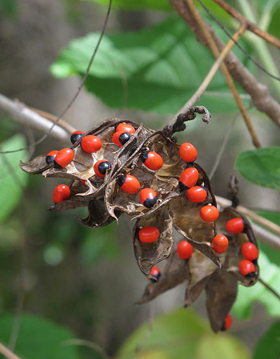
Syn : Abrus minor and A. pauciflorus Desv.
English names: Indian liquorice, Crab's eye.
Sanskrit name: Krishna gunja.
Vernacular names: Asm : Latuwani; Ben: Rati, Kunch; Guj: Gumchi; Hin and Pun: Rati; Kan : Gurgunn, Gulaganji; Ori : Kaincha, Gunja; Mal: Kunnikkura; Tam: Kunthamani; Tel: Gumginja.
Trade names: Rati, Kunch.
Traditional use: SANTAL: (i) grind the roots, make small pills, encase the pills in molasses and eat the same to treat night-blindedness; (ii) make a plaster by grinding the roots of white-fruited variety and apply the plaster on the painful part of inflammated sections of the gum; (iii) to treat white-coloured urine they drink a mixture made by grinding roots of the following: (a) white-fruited A. precatorius, (b) Indigofera pulchella, (c) Panicum repens and (d) Spatholobus roxburghii; (iv) to treat gravel they drink a mixture made of the following: (a) roots of A. precatorius, (b) the refuse of molasses, (c) exudation from a sapling of Diospyros tomentosa, (d) exudation from Acacia catechu, (e) little saltpeter, and (f) pinch of sulphur; (v) to treat the variety of childbed complaints (usually caused by anaemia) characterized by profuse diarrhoea, roots of A. precatorius are used in preparing two different varieties of mixtures; the ingredients of the mixtures are given below: (a) first variety: roots of A. precatorius, Elaeodendron roxburghii, Coix lachryma-jobi, Piper longum, Ruellia suffruticosa, white onion, rhizome of Zingiber officinale; (b) second variety: roots of A. precatorius, Coix lachryma-jobi, Embelia robusta, Piper longum, bark of Casearea tomentosa, Elaeodendron roxburghii, Gmelina arborea, Emblica officinalis, white onion, leaves of Ocimum sanctum, rhizome of Curcuma angustifolia and Zingiber officinale - all these are ground together, boiled and mixed with the refuse of molasses; (vi)roots as abortifacient and in paralysis; (vii) apply leaf-paste with lime-water (2:1) on swelling of glands; (viii) grind the leaves of white-flowered A. precatorius, warm slightly and plaster on the loins to kill pain there; (ix) grind leaves of A. precatorius along with leaves of Lawsonia alba and Tamarindus indica (1:1:1), add a little salt, boil a little and apply the plaster on the whole body to get relief from muscular pain caused by overexhaustion; (x) make a paste of leaves of A. precatorius along with roots of Carissa carandas and Gossypium arboreum, warm the paste slightly and plaster the same over the whole body of the patient suffering from stealth convulsions; (xi) leaf-paste in leucoderma; (xii) seed-paste in skin diseases; (xiii) seeds after some processing as contraceptive. MUNDA: Root-paste in gonorrhoea. ORAON: dried root-powder as mild purgative.
AGNI PURANA: (i) husks of A. precatorius along with the same of Vitis vinifera and the decoction of Polyalthia longifolia, Moringa pterigosperma, payomuca and tripha/a (fruits of Terminalia belerica, Terminalia chebula and Emblica officinalis) destroys all intestinal worms; (ii) the mixture of powder of A. precatorius, marine salt and pathya in warm water removes all fevers; (iii) consumption of the seeds of A. precatorius along with the fruits of Melia azadiracta, Holarrhena antidysenterica (leaves). Acorus calamus (young leaves) and Glycyrrhiza glabra (powder of stem) causes vomiting; (iv) regular drinking of A. precatorius along with Acorus calamus, G/oriosa superba, vasa, nisagada, Zingiber officinalis, Glycyrrhiza glabra and marine salt daily in the morning enhances memory of young boys; (v) A. precatorius can enhance the span of a man's life, if it is eaten with marine salt and some other plants (Tinospora cordifolia, pathya, citraka, dried rhizome of Zingiber officinalis).
Modern use: Roots: emetic and alexiteric; Decoction of roots and leaves: for cough, cold and colic; Seeds: purgative, emetic, tonic, aphrodisiac, used in nervous disorder and cattle poisoning; Poultice of seeds: as suppository to bring about abortion; Paste of seeds: applied locally in sciatica, stiffness of shoulder joints and in paralysis.
Phytography : Copiously branched climber with slender branches; leaves alternate, pinnately compound with numerous deciduous leaflets; flowers small, in dense racemes on axillary peduncles or short branches; pods 2.5-3.7 by 1.0-1.25 cm; seeds bright scarlet and black or whitish or black or mixed black and white, large like pea.
Phenology: Flowering: August and September; Fruiting : January to March (even up to May).
Distribution: Occurring throughout greater parts of India, ascending the outer Himalaya up to 1200 m, occasionally planted in gardens.
Ecology and cultivation: Naturalised in tropical countries.
Chemical contents: Root and Leaf: glycyrrhizin, isoflavanquinones, abrusquinone A, B & C; leaves taste sweet and roots less so; roots also contain precol, abrol, abrasine and precasine. Seed: poisonous, principal constituents being 'abrin'; a fat-splitting enzyme, haemaagglutinin, urease; alkaloid (abrin), a glucoside (abralin) and a small quantity of fatty oil have also been isolated from seed. Pharmacologically,abrin is considered to be intensely poisonous. Besides abrin, a seed contains hypaphorine, two steroidsone oily and the other crystalline- β-sitosterol, stigmasterol, 5 B-cholanic acid, abricin, abridin, cholesterol, lectins and toxic proteins.
Remark: Root is used as an adulterant of the root of Glycyrrhiza glabra (Fam. Fabaceae).
Top
Acanthus ilicifolius L. (Acanthaceae)
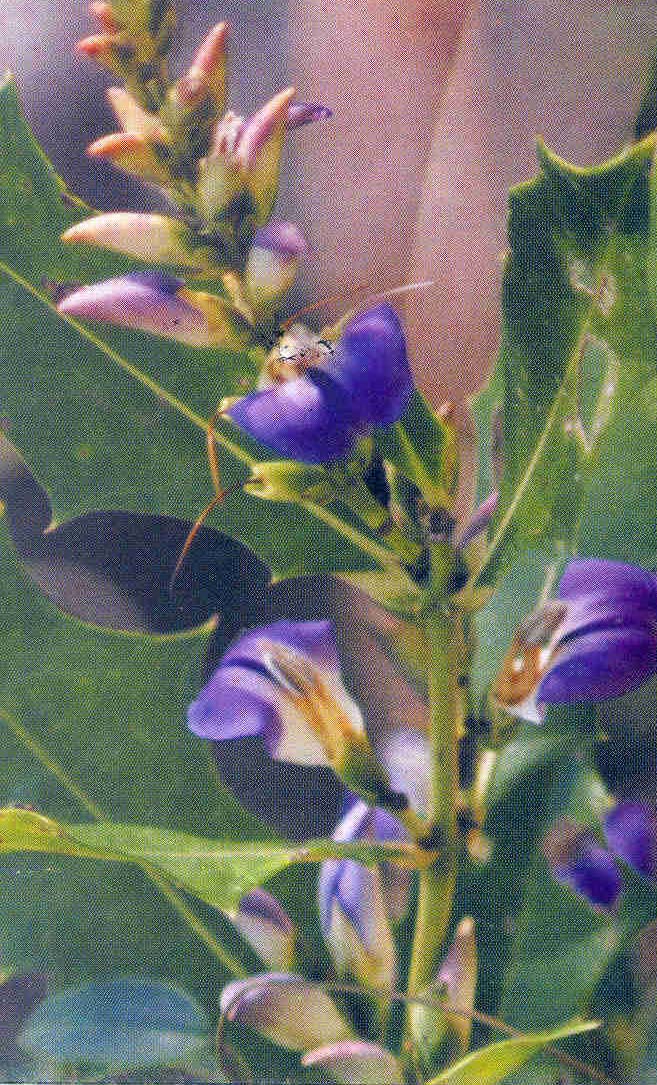
Syn : Acanthus doloarius Blanco, Dilivaria iIicifolia Nees
Sanskrit name: Harikasa.
Vernacular names: Ben: Hargoza, Harkachkanta; Kan : Holeculli; Mal: Payinaculli; Mar: Maranda, Maraneli; Ori : Harkamcli; Tam: Kalutai mulli; Tel: Alei.
Trade name: Harkasa.
Traditional use: TRIBES OF SUNDARBANS: Root (boiled in mustard oil): in paralysis of limbs; FOLKS OF GOA: Leaf: as fomentation in rheumatism and neuralgia.
Modern use: Plant: in asthma; Decoction of plant: in dyspepsia; Leaf and tender shoot: in snake bite; Root: in asthma, paralysis, leucorrhoea and debility; Leaf: as fomentation in rheumatism, neuralgia and in snake bite.
Phytography : Erect herb; stems up to 1.5 m, in clumps, little divided, glabrous; leaves shortly petioled, oblong or elliptic, base usually spinous, toothed or, pinnatifid,rigid, glabrous; spikes 10-40 cm, terminal, commonly solitary; flowers mostly opposite, bract and bracteoles present, sepals 4, outer 2 elliptic rounded, inner 2 broadly lanceolate, subacute, petals 5, blue, united, 2-lipped, corolla tube short, pubescent within, stamens 4, didynamous, shorter than coroll_ lip, filaments stout, anthers 1-lobed, bearded, carpels 2, united, ovary 2-chambered having 2 ovules in chamber, style short, bifid; capsules shining chestnut-brown, ellipsoid, compressed, 0.6-0.8 cm long; testa white, very lax.
Phenology: Flowering and Fruiting: almost throughout the year.
Distribution: Mangroves of Indian peninsula; Sri Lanka, Bangladesh, Pakistan and the adjoining areas.
Ecology and cultivation: Commonly grown on the river banks, tidal canal sides, low swampy areas in the mangrove forests and its vicinity; wild.
Chemical contents: Plant: acanthicifoline, oleanolic acid, β-sitosterol, lupeol, quercetin and its glucopyranoside, trigonellin; Root: saponin, glycoside of 3α-OH-lup-20(29)-ene.
Top
Aconitum ferox Wall. (Ranunculaceae)
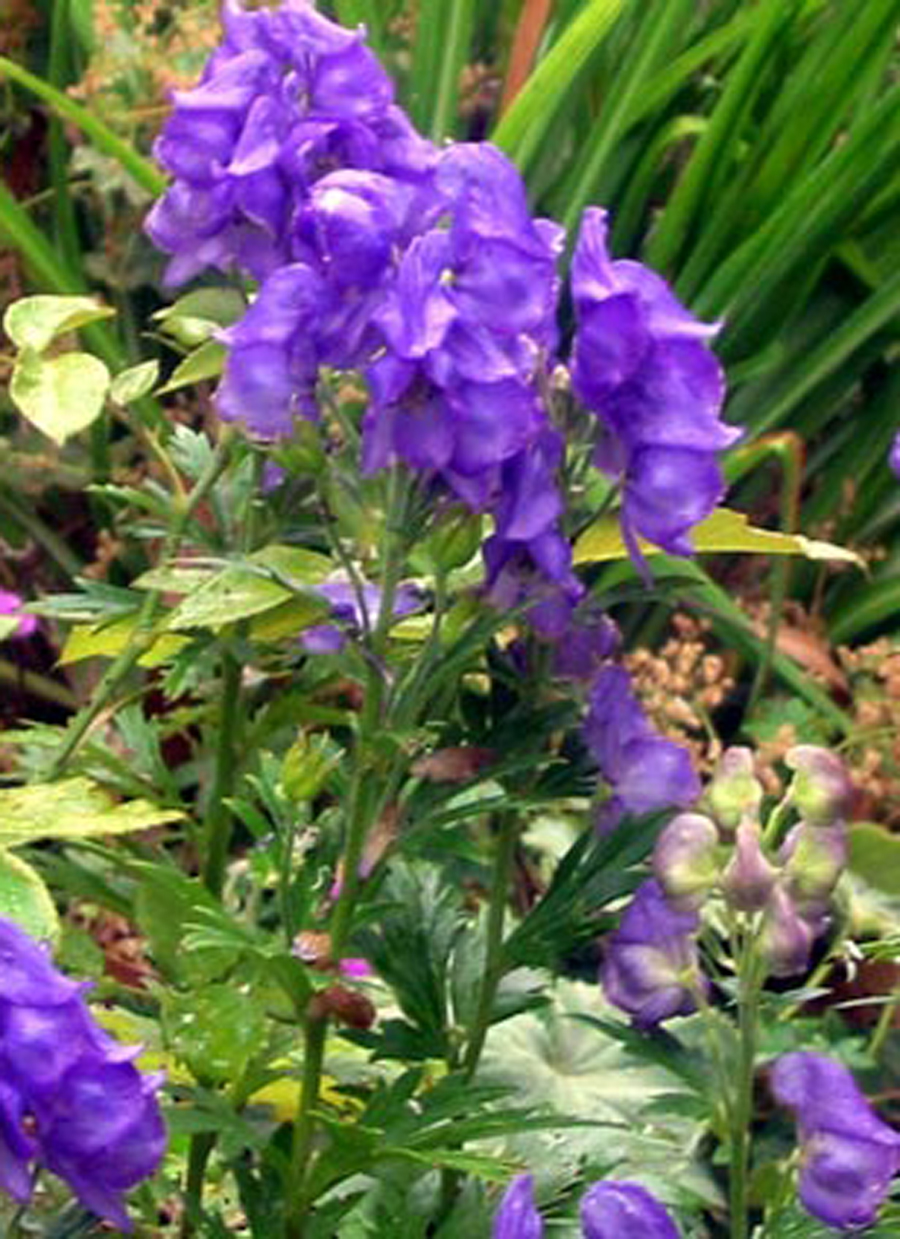
Syn: Aconitum virosum Don., A. napellus var. rigidum Hook, f & T.
English names: Wolf's bane, Indian aconite.
Sanskrit names: Vatsanabha, Visa.
Vernacular names: Hin: Bish, Mahoor; Guj and Mar: Vachang; Kas: Mohra; Tam: Vasnumbi; Tel: Vasnabhi.
Trade name: Bish.
Traditional use: AYURVEDA : Root: used in the mrityunjaya rasa (used to treat the fever supposed to be caused by deranged vayu, i.e., wind, sannipatika jvara, i.e., remittent fever, hingulesware-rasa, anandabhairav agnitundi vati, etc.
Vatsanabha has been used in medicine from a very remote period. It is regarded as healing and stimulant. It is used in a great variety of affections, but is specially recommended in fever, cephalagia, affections of throat, dyspepsia and rheumatism. HOMOEOPATHY: remedy for clotting of blood in heart or in lungs, pneumonia, Iymptisis, pleurisy, eye trouble, earache, toothache and urinary trouble.
Modern use: Extremely poisonous; used in leprosy, fever, cholera, nasal catarrah, tonsillitis, sore throat, gastric disorders, debility, etc., also used as a sedative and diaphoretic; applied in the form of paste in cases of neuralgia and rheumatism.
Phytography : Perennial erect herb growing up to 2 m in height; roots look like the navel of children; leaves alternate, simple, rounded or oval, may be palmately 5-lobed; flowers borne on branched racemes, bracts and bracteoles present, large helmet-type, helmet vaulted with short sharp beak, pale dirty blue in colour, zygomorphic, floral parts arranged spirally on an elongated receptacle; follicles erect, usually densely villose-sometimes glabrous.
Phenology: Flowering and Fruiting: July-November.
Distribution : Alpine Himalaya including Nepal; endemic.
Ecology and cultivation: Temperate to alpine regions of the Himalaya in the altitude of 3300-5000 m.
Chemical contents: Root: pseudoaconitine (a toxic alkaloid), indactonitine, chasmaconitine, bikhaconitine.
Adulterants: Indian aconite root is known as 'bikh' or 'bish', the name which is applied to aconite from more than one species, and different authors have ascribed it to different species.
Remarks: Vulnerable due to excessive collection for medicinal uses. Collection in wild state should be banned and measures for cultivation should be initiated.
Top Home
Acorus calamus L. (Araceae)
Syn : Acorus griffithii Schott., A. belangeii Schott, A. casia Bertol.
English name: The sweet flag.
Sanskrit name: Vacha.
Vernacular names: Asm, Ben and Hin : Boch; Gui : Godavaj, Vekhand; Kan : Baje, Baje gida; Kon: Waikhand; Mal: Vayambu; Mar: Vekhand; Ori : Bacha; Pun: Bari, Boj, Warch; Tam: Vasamboo; Tel: Vasa.
Trade name: Boch.
Traditional use: SANTAL: use the plant in the following ways: (i) they mix and grind black pepper, cloves, root of Carissa carandus lo along with little of the rootstock of A. calamus lo, then stir the same in pure mustard oil-the emulsion, thus prepared is anointed daily over the whole body of the patient suffering form epilepsy with foaming and groaning, as soon as the fit comes on; a few drops of this emulsion should be poured into the nose of the patient; (ii) for the treatment of indigestion, they take pills made by grinding 100 black peppers, little amount of ginger and the root of A. calamus together; (iii) also use in the treatment of asthma, bronchitis, cold and cough, dry cough, epilepsy, haemoptysis, indigestion, phthisis; BIRHOR : Rhizome in alopecia, Root as massage, in fever, hysteria, pain in neck, teething trouble of children, malaria and cancer.
AGNI PURANA : this plant is of great medicinal value; it recommends the following uses: (i) for treatment of epilepsy, this plant should be boiled with Costus speciosus, shankhapushpi, along with the juice of Bacopa monnieri ; the substance thus obtained should be administered to the patient; (ii) drinking the decoction of this plant, Piper peepuloides, Staphyles emodi Wall., and Cyperus parviflorus Heyne and pippalimula is good for the patient of rheumatic arthritis; (iii) the powder or decoction of this plant helps curing chronic enlargement of spleen; (iv) decoction of the plant is beneficial for the patient of dropsy; A YURVEDA: Rhizome: bitter, healing, emetic, laxative, diuretic, carminative; improves voice and appetite; good for oral diseases, abdominal pain, epilepsy, bronchitis, hysteria, loss of memory, rat bite and worms in ear.
SIDDHA SYSTEM: fresh root for bronchial asthma.
UNANI: an ingredient of the medicine called 'Waje-Turki'; useful in flatulent colic, chronic dyspepsia, catarrhal, in burn wounds, carminative, anthelmintic and as bitter tonic.
Modern use: Rhizome: aromatic, bitter, carminative, emetic, stimulant, stomachic, useful in dyspepsia, colic, remittent fevers, nerve tonic, in bronchitis, dysentery, epilepsy and other mental ailments, glandular and abdominal tumours and in snake bite.
Phytography: Perennial, erect, aromatic herb, common on river banks and marshes, ascending to 3000 m; rhizome cylindrical or slightly compressed, about 2.5 cm in diameter, much-branched, externally light brown or pinkish brown but white and spongy within; leaves distichous, large, 1-2 m in length, base equitant, margin waved; spadix sessile, cylindric, densely flowered, not completely enclosed by spathe, spathe 15-75 cm in length, narrow, leaf-like; flowers small, bisexual; berries few-seeded; seeds oblong, albuminous.
Phenology: Flowering and Fruiting: July-August; fruiting very rare.
Distribution: Throughout India; ascending the Himalaya up to 2000 m; Sri Lanka, Pakistan and Bangladesh.
Ecology and cultivation: Probably introduced; found from the coast to 1200 m; often near village wells and along watercourses; confined to marshy areas; gregarious herb from a stout horizontal rhizome; wild and cultivated.
Chemical contents: Dry rhizome :1.5-3.5% of a yellow aromatic volatile oil-calamus oil; the oil contains β-asarone, small quantities of sesquiterpenes and sesquiterpenes alcohols; Rhizome: also contains choline (0.26%), flavone, acoradin, 2,4,5-tri-MeObenzaldehyde, 2,5-di-MeO-benzoquinone, galangin, calameone, acolamone, isoacolamone, epoxyisoacoragermacrone; Aerial parts: lutcolin-6,8-c-diglucoside; chemical constituents vary in ecotypes and polyploides.
Adulterants: The powdered drug has been adulterated with siliceous earth, ground marsh mallow root and cereal flowers.
Remark: Rhizomes are valued for indigenous medicine.
Top
Aegle marmelos Corr. (Rutaceae)

Syn: Feronia pellucida Roth, Crataeva religiosa Ainslie
English names: Wood apple, Bael tree.
Sanskrit names: Bilwa, Shriphal.
Vernacular names: Asm and Ben: Bel; Guj: Biliva phal, BiI; Hin : Shriphal, Bel; Kan: Bilwa patre, Bil patre; Kon : Belfoll; Mal: Vilvam, Koovalam; Mar: Bel; Ori : Bela; Pun: Bil; Tam: Vilvam, Vilvamaram; Tel: Bilambu, Maredu; Urd: Bel.
Trade names: Bel, Shriphal.
Traditional use: SANTAL: (a) leaves of this plant along with {i} many other plant materials for the treatment of continuous fever; (ii) the molasses and fruits of Gryllus monostrosus for the treatment of diseases without premonitory symptoms; {iii} the fruits of Nigella indica and black pepper to treat a patient of convulsions; (iv) the leaves of Melia azadirac hta and the seeds of Semecarpus ana cardium to treat nausea; (v) the fruits of Randia dumetorum and Nigella indica, oilcake of Bassia latifolia, salt and Carum ajowan for treatment of constipation with meteorismus; (vi) the bark of the following plants Pterocarpus marsupium, Bauhinia vahlii, Spatholobus roxburghii, Terminalia tomentosa, Dalbergia latifolia and fried rice for treatment of chronic stomachache and (vii) the bark of Odina wodier, salt and Carum ajowan to treat watery diarrhoea; (b) various parts of fruit for making the following medicines: (i) for curing the patient of cholera, a medicine prepared with the following, is administered: the old fruit of A. marmelos, bark of Melia azadirachta, the resin of Shorea robusta and pulverized kernel of a mango stone; (ii) a sherbet prepared with the ripe fruit of A. marmelos and sugar candy is administered to the patient of dysentery; (iii) to treat the complaints of a mother after child-birth, a plaster made of the following is applied: top of the fresh unripe fruit of A. mermelos, leaves of Ocimum sanctum, little ginger and 84 blac_ peppers; (iv) a patient of puerperal fever is given a liquid drink made with the entire contents scraped out of a ripe fruit of A. marmelos, juice of old dried fruits of Mangifera indica, two ounces of a kind of red ants and a little salt; (v) a thick mixture, made with twin fruits of A. marmelos, melted hail and earth excavated by rats, is smeared on the breasts of a young mother to check the flow of milk when the breasts pain or suppurate; and (c) the bark of old trees of A. marmelos and Melia azadirachta are used to prepare an antidote for the poison of all kinds of snake bite; ATHARVAVEDA : the unripe fruit medicinal, but ripe fruit harmful; CHARAKA SAMHITA: the unripe fruit increases the digestive power, but the ripe fruit is difficult to digest; KURMA PURANA: (i) regular drinking of fruit juice ensures long span of life and golden colour of the skin; (ii) brushing the teeth with young branch of this plant is beneficial;
MATSYA PURANA : the paste of this plant is a good steriliser for clothings, beds, furniture, coat of armour, ornaments, canopy and fans made of wools and furs; BRAHMAVAIVARTA PURANA : consumption of ripe fruits of this plant helps to eliminate the ailment caused by excessive bile, but drinking water immediately after eating the fruit aggravates the bile-disorder; AGNI PURANA : (i) this plant is of great medicinal value; (ii) inhaling the oil, obtained from this plant, increases the poetic acumen of the inhaler and enables him to live a long life; (iii) for treatment of gastroenteritis, the patient should drink (a) the water containing the decoction of A. marmelos, Aconitum heterophyllum and Holerrhena antidysenterica, (b) the fruit juice of A. marmelos, Mangifera indica, Dolicos lablab, Woodfordia fruticosa, shunthi along with buttermilk and molasses; and (iv) it can cure a patient suffering from fever and its associate pains and cough.
UNANI: Ingredient for 'Belgiri'.
HOMOEOPATHY: Destroys phlegm and a good remedy in fevers associated with catarrhal symptoms, also good for dropsy, bleeding piles, dysentery, diarrhoea, bowel complaints and is a good laxative.
Modern use: Fruits: chiefly used in (i) chronic diarrhoea and dysentery; (ii) as a good laxative, and the sherbet prepared from the pulp is good for bacillary dysentery; Half-ripe fruit: astringent, digestive and used in diarrhoea. It is also antidiuretic, anthelmintic, antipyretic, carminative, tonic.
Phytography: Deciduous glabrous tree, up to 8 min height and 1 m in girth, bark shallowly furrowed and corky; leaves alternate, with straight sharp axillary thorns (buds), trifoliate, aromatic; flowers in axillary panicles, greenish white, fragrant; fruit hard-shelled, up to 5 cm in diameter, greyish or yellowish, scented, pulp orange, sweet and gummy; seeds numerous, oblong, compressed, testa mucous.
Phenology: Flowering: April-May; Fruiting: persistent, ripening by February.
Distribution: Found in the plains and submontane regions of India, wild in the sub-Himalayan tract, often planted.
Ecology and cultivation: Wild; often planted.
Chemical contents: Bark of root and stem: umbelliferone, other coumarins, β-sitosterol, aurapten, marmin, lupeol, two unidentified alkaloids and two unknown compounds-their proportion varies with the age of the bark; Stem: yields a good gum; Heartwood: a ferro-quinoline alkaloid,/dictamine, marmasin and β-sitosterol; Leaves: γ-sitosterol, aegeline, aegelenine, lupeol; sitosterol, rutin, marmesinin, β-sitosterol, glucoside and essential oil; Fruits: psoralen, aegelinol, furanocoumarin, marmelide, β-sitosterol and essential oil; Ripe fruits: xanthotoxol, scoparone, scopoletin, umbelliforone, marmesin, skimmin and β-sitosterol glucoside.
Adulterants: Umonia acidissima Correa, Garcinia mangostina L. and Puilica granatum L. are used as substitute of Aegle marmelos Correa.
Top Home
Allium sativum L. (Alliaceae)
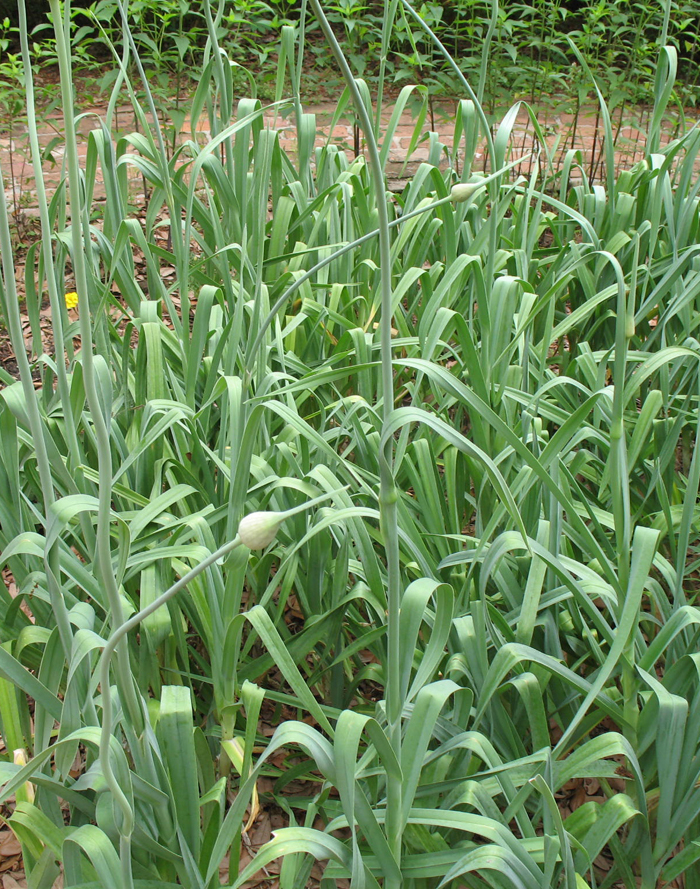
English name: Garlic.
Sanskrit names: Arishta, Lashuna, Mahausada, Rason.
Vernacular names Asm : Naharu; Ben: Rasun; Guj : Lasan, Shunam; Hin : Lashun; Kan : Belluli; Kon : Lossun; Mar: Velluli, Velluthulli; Mar: Lasun; Ori : Rasun; Tam: Vellaipundu; Tel: Tellagadda.
Trade names: Rasun, Lashun.
Traditional use : UPAVARHANA SAMHITA : good for health; AGNI PURANA: a mixture of this plant, ginger and Moringa oleifera is helpful for eye and also as eardrop.
MATSYA PURANA : of great medicinal value, should be stored in forts.
UNANI: an ingredient of 'Seer (Lahsan)'.
HOMOEOPATHY: Mother tincture, a good remedy for cough and cold, pain in the chest, swelling of glands, psoas, iliacus and erosion of old diseases at the adimanic stage.
Modern use: Bulb: antidiabetic, antiinflammatory, anticancer, effective in rheumatism, catarrhal conditions; Raw garlic: decreases glucose, cholesterol, phospholipids, triglycerides, useful in dyspepsia, cryptococcal meningitis, rickettsia; applied externally as resolvent to indolent tumours, internally given with common salt in nervous diseases, headache; Liniment: beneficial in infantile convulsion and other spasmodic affections; Juice: applied to bruises and sprain, relieves earache, allays pain in otorrhoea; preparation have been given to pulmonary phthisis, bronchitis, gangrene of the lung and whooping cough; Garlic juice: good for treatment of laryngeal tuberculosis, lupus and duodenal ulcer; Inhalation of fresh garlic juice: useful in pulmonary tuberculosis, dyspepsia, flatulence and colic; in external application, the juice is used as a rubifacient; in skin diseases, as an eyedrop and in earache.
Phytography : Hardy perennial bulbous scapigerous herb; stem flat, dry, lower portion of the plant forms bulb which consists of several smaller bulbs called cloves, surrounded by a thin white or pinkish sheath; leaves flat, narrow green; heads bear small white flowers and bulbils.
Phenology: Flowering and Fruiting: Winter.
Distribution: Cultivated throughout India since ancient days; also cultivated in Pakistan, Bangladesh and almost in all tropical countries.
Ecology and cultivation: It favours a richer soil and higher elevation (1000-1300 m), well-drained, moderately clayey loam is best suited for cultivation; requires a cool, moist period during growth and a relatively dry period during maturing of the crop; takes 4-5 months to mature, harvested during February to April. Yields good results, if treated with farmyard manure and top-dressing of ammonium sulphate mixed with superphosphate. It grows as a late irrigated crop; in South India, it is rotated with ragi.
Chemical contents: Garlic: protein 6.3%, fat 0.1 %, carbohydrate 29%, Ca 0.03%, Fe 1.3 mg/100 g, vitamin C 13 mg/100 g, and also Cu-peptides, 2 mercapto-L-cysteins, anthocyanins, glycosides of kaempferol and quercetin, polysaccharides, allinase, sterols, hydrocarbons, alliin (nonvolatile sulpher amino acid), sativin I & II, scordinines A & B; Essential oil: the bulbs, on distillation, yield 0.06-0.1 % of an essential oil containing allyl-propyl-disulphide, diallyl disulphide and two sulphur containing compounds.
Top Home
Aloe barbadensis Mill. (Liliaceae)
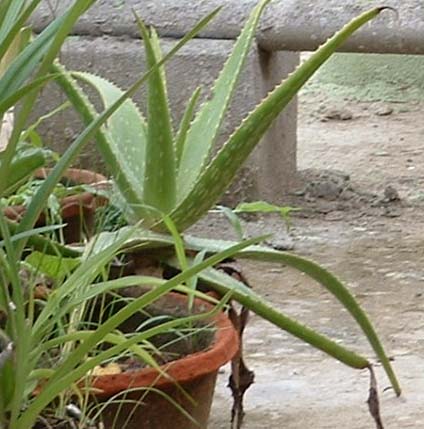
Syn : Aloe indica Royle, A. littoralis Koening., A. vera Tourn. ex Linn.
English names: Barbados aloe, Curacas aloe, Indian aloe, Jafarabad aloe.
Sanskrit name: Ghritakumari.
Vernacular names: Asm : Chalkunwari; Ben: Ghritakumari; Guj : Kumarpathu, Kunvar; Hin : Ghee kunvar; Kan : Lolesara; Kon : Kantikkor, Katkunvor; Mal: Kattarvazha kumari; Mar: Korphad; Ori : Gheokunri; Pun: Ghikur, Kawargandal; Tam: Alagai, Chirukuttali, Kuttilai; Tel: Chinnakata banda, Kala banda, Kittanara.
Trade names: Ghritakumari, Ghee kunvar.
Traditional use: TRIBAL: Leaf-pulp: in liver troubles, jaundice, fever, gonorrhoea, spleen disorder, rheumatism, piles, dysmenorrhoea, sterility in women; Leaf-mucilage: mild laxative, to cure hardening of breast tissues, in insect stings.
AYURVEDA: alternative, bitter, cooling, purgative, sweet, tonic, anthelmintic, useful in eye diseases, tumours, enlargement of spleen, liver troubles, vomiting, skin diseases, biliousness, asthma, leprosy, jaundice, strangury, ulcer; Flowers: anthelmintic.
UNANI: Gheekawar is useful in inflammation of spleen, lumbago, muscular pain, ophthalmia, digestive, purgative; Leaves good for piles and biliousness.
Modern use: Aloe: in menstrual diseases, stomach pain, tonic after pregnancy, uterine disorders, high fever; Pulp: menstrual suppressions, nervous imbalance; Aloe compound: in treatment of women sterility; Mucilage: painful inflammation; Root: colic pain; Aloe mixture with other plant extracts: for treating obstruction of lymphatic system.
Phytography : A coarse-looking plant with a short (30-60 cm high) stem; leaves succulent, green, large (37 cm long, 10 cm broad, 2 cm thick), densely crowded; flowers in racemes, bright yellow, tubular, stamens frequently projected beyond the perianth tube.
Phenology: Flowering: September-December; Fruiting: scarce.
Distribution: A native of North Africa, Canary Islands and Spain; naturalised in India; many varieties are found in a semi-wild state in all parts of India; also cultivated in pots and gardens.
Ecology and cultivation: Xerophyte; propagated by suckers.
Chemical contents: Plant: aloin, aloe-emodin and resins.
Adulterant: Aloe candelabrum Berger is used as substitute for Aloe barbadensis Miller.
Syn : Aloe indica Royle, A. littoralis Koening., A. vera Tourn. ex Linn.
English names: Barbados aloe, Curacas aloe, Indian aloe, Jafarabad aloe.
Sanskrit name: Ghritakumari.
Vernacular names: Asm : Chalkunwari; Ben: Ghritakumari; Guj : Kumarpathu, Kunvar; Hin : Ghee kunvar; Kan : Lolesara; Kon : Kantikkor, Katkunvor; Mal: Kattarvazha kumari; Mar: Korphad; Ori : Gheokunri; Pun: Ghikur, Kawargandal; Tam: Alagai, Chirukuttali, Kuttilai; Tel: Chinnakata banda, Kala banda, Kittanara.
Trade names: Ghritakumari, Ghee kunvar.
Traditional use: TRIBAL: Leaf-pulp: in liver troubles, jaundice, fever, gonorrhoea, spleen disorder, rheumatism, piles, dysmenorrhoea, sterility in women; Leaf-mucilage: mild laxative, to cure hardening of breast tissues, in insect stings.
AYURVEDA: alternative, bitter, cooling, purgative, sweet, tonic, anthelmintic, useful in eye diseases, tumours, enlargement of spleen, liver troubles, vomiting, skin diseases, biliousness, asthma, leprosy, jaundice, strangury, ulcer; Flowers: anthelmintic.
UNANI: Gheekawar is useful in inflammation of spleen, lumbago, muscular pain, ophthalmia, digestive, purgative; Leaves good for piles and biliousness.
Modern use: Aloe: in menstrual diseases, stomach pain, tonic after pregnancy, uterine disorders, high fever; Pulp: menstrual suppressions, nervous imbalance; Aloe compound: in treatment of women sterility; Mucilage: painful inflammation; Root: colic pain; Aloe mixture with other plant extracts: for treating obstruction of lymphatic system.
Phytography : A coarse-looking plant with a short (30-60 cm high) stem; leaves succulent, green, large (37 cm long, 10 cm broad, 2 cm thick), densely crowded; flowers in racemes, bright yellow, tubular, stamens frequently projected beyond the perianth tube.
Phenology: Flowering: September-December; Fruiting: scarce.
Distribution: A native of North Africa, Canary Islands and Spain; naturalised in India; many varieties are found in a semi-wild state in all parts of India; also cultivated in pots and gardens.
Ecology and cultivation: Xerophyte; propagated by suckers.
Chemical contents: Plant: aloin, aloe-emodin and resins.
Adulterant: Aloe candelabrum Berger is used as substitute for Aloe barbadensis Miller.
Top Home
Alstonia scholaris R. Br. (Apocynaceae)

Syn : Echites scholaris L., E. pala Ham.
English names: Devil's tree, Dita bark.
Sanskrit names: Saptaparni, Saptaparna, Sarada, Vishalalvaka, Vishamachhda, Ayugmaparna, Gandhiparna, Payasya, Jivani, Kshalrya, Madagandha, Grahashi, Grahanashana.
Vernacular names: Asm : Chatiar; Ben: Chhatim; Hin : Chatian, SaIni chatian; Kan : Saptaparna, Maddale, Kodale, Elele kale, Janthalla, Hale; Ken: SantnarUkh; Mal: Ezhilampala, Mukkampala, Pala; Mar: Salvin; Ori : Chhatiana, Chhanchania; Silgandha; Pun: Satona; Sin: Rukattana; Tam: Elilaipillai, Mukumpalei, Pala, Wedrase; Tel: Eda kula, Pala garuda.
Trade names: Chatiyan, Shaitan wood, Saptaparni.
Traditional use: MUNDAS OF CHOTANAGPUR : Bark: in colic pain; SOME PARTS OF INDIA: Plant: used in the treatment of leprosy; Twig: hung in the room of the newly confined woman to lessen the activities of evil spirit on the new born.
ATHARVA VEDA: preventive and curative of diseases caused by change of season. CHARAKA SAMHITA and SUSHRUTA SAMHITA: good for headache, sores, and some other diseases; A YURVEDA : the following uses are recommended: (i) Bark: dermal so"res, ragging fever, discharge of sperm with urine, hiccup, insufficiency in breast milk, gout, cold congestion, dyspepsia; (ii) Latex: caries, pimple, pyorrhoea; (iii) Flower: asthma, respiratory troubles.
UNANI: Ingredient of 'Kashim'.
HOMOEOPATHY: Malarial fever, anaemia, indigestion, general debility and other stomach ailments.
Modern use: Bark: known in commerce as Dita bark and is used in medicine as bitter, febrifuge and astringent, in treatment of malarial fever, chronic dysentery, diarrhoea and in snake bite; Milky juice: applied to ulcers.
Phytography: Large (20 m high, 3 m girth), evergreen tree with straight, often fluted and buttressed base, branches whorled, bark yellow inside and exudes milky bitter latex; leaves simple, whorled-usually 7 in a whorl, coriaceous, whitish beneath, obovate or elliptic or oblong, obtuse rounded or obtusely acuminate, 30-60 pairs of horizontal veins joining an intramarginal one; cymes peduncled or sessile, umbellately branched; flowers aromatic, 0.8-1.25 cm in diameter, greenish white, pubescent; follicles 30-60 cm long and 0.3 cm in diameter, pendulous, in clusters.
Phenology: Flowering: Autumn; Fruiting: Winter.
Distribution: Throughout moist regions of India, especially in West Coast forests, in the Himalaya it ascends up to 1000 m; also found in Bangladesh and Pakistan. Planted in the gardens.
Ecology and cultivation: Also grown as an ornamental.
Chemical contents: Root and Root-bark: echitamine chloride, α-amyrin, lupeol-OAc, stigmasterol, β-sitosterol, campesterol, alkamicine-its Nb-oxide and Nb-metttiodide, γ-akummicine, Nb-di-Me-echitamine, tubotaiwine; Stem-bark: hydrochloride of echitamine, echitamidine, a glyceride of venotarpine, sterols, two isomeric lactones; Latex: caoutchouc and resins; Leaf: picrinine, nareline, akuammidine, picralinal, akuammigine, betulin, ursolic acid, β-sitosterol, flavonoids, phenolic acids, scholarine; Flower: picrinine, strictamine, tetrahydroalstonine, n-hexacosane, lupeol, β-amyrin, palmitic acid, ursolic acid.
Adulterants: Alstonia macrophylla Wall. and A. venenata R. Br. are used as substitute for A. scholaris.
Top Home
Anacardium occidentale L. (Anacardiaceae)
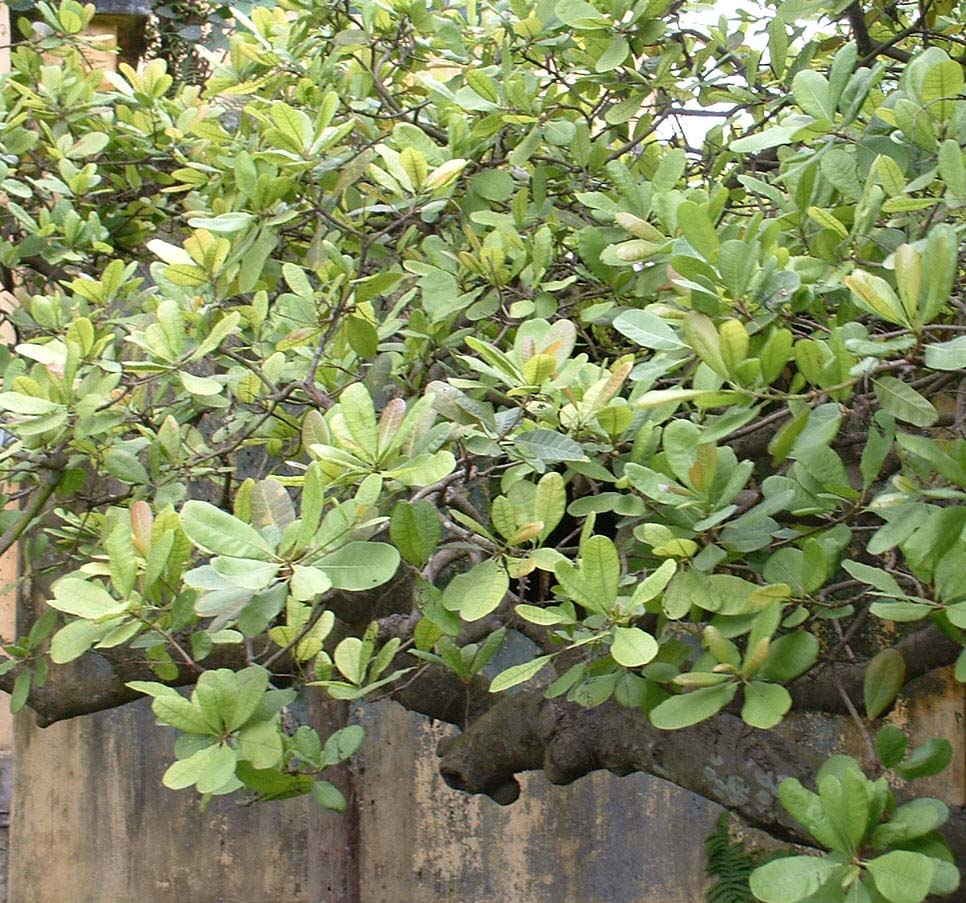
English name: Cashew nut.
Vernacular names: Asm : Kaju badam; Ben: Hijli badam, Kaju badam; Guj, Hin, Mar and Pun: Kaju; Kan : Gerupappu; Godambi; Kon: Kaz; Mat: Kashumaru, Parankimara, Andiparuppau; Ori : Lanka badam; Tam: Mundiri, Munthirikai; Tel: Jidimamidi, Muntha mamidi.
Trade names: Cashew nut, Kaju.
Traditional use: Cashew nut shell-oil: mild purgative, used in folk medicine for treatment of hookworm, cracks on soles of feet, warts, corns, leporus sores.
Modern use: Cashew nut: used in mental derangement, sexual debility, nervous prostration following seminal emission, morning sickness in pregnancy, palpitation of heart, rheumatic percarditis, loss of memory as a sequel to small pox; Kernel: good for week
patients suffering from I incessant and chronic vomiting; Kernel-oil: antidote for irritant poisons; Liquor made from fruit: diuretic.
HOMOEOPATHY : for boils, warts, wounds and different types of cracks in legs; used sometimes in case of leprosy.
Phytography : Small tree with short, thick, crooked trunk; leaves simple, alternate, petiolate, entire, hard, 1020 cm by 7.5-12.5 cm; panicles terminal, bracteate, pubescent; branches long, naked to the tips; flowers yellow with pink stripes, 0.8 cm in diameter; cashew apple red or yellow-is the swollen, enlarged pedicel which bears the nut.
Phenology: Flowering: March-April; Fruiting: April-May.
Distribution: Native to tropical America, naturalised in the hotter sea-shores of India; Pakistan, Bangladesh and Malaysia.
Ecology and cultivation: Introduced; grows in plains, especially towards the coast, very occasionally ascending up to 1200 m; being extensively planted by clearing scrub jungles in the plains.
Chemical contents: Bark: exudes gum; Flower: polyphenols; Cashew shell: yields gum, oil and liquid (CNSL); Liquid-free nutshell: syringic and gallic acids, galocatechin; Defatted nutshell: naringenin, prunin-6"-O-p-coumarate; Cashew apple liquor: vitamin C, vitamin E; Reddish brown testa: D-catechin, gallic acid, caffeic acid, quinic acid, polyphenols, bioflavone.
Top
Andrographis paniculata (Burm. f.) Wall. ex Nees (Acanthaceae)
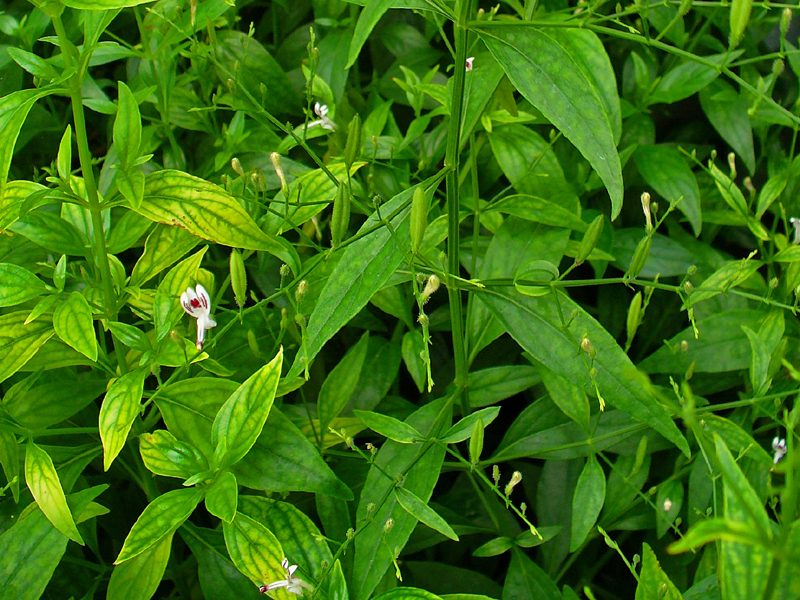
Syn : Justicia paniculata Burm. f.
English names: The great king of bitters, the creat. Sanskrit names: Bhunimba, Kirata.
Vernacular names: Ben: Kalmegh; Guj : Kariyatu; Hin: Kirayat; Kan: Nelabaru; Mar: Olikiryata; Tam and Tel: Nelavemu.
Trade names: Kalmegh, Kirayat.
Traditional use: Plant:. febrifuge, alterative, anthelmintic, anodyne, useful in debility, diabetes, consumption, influenza, bronchitis, itches and piles; in Bengal, household medicine known as 'Kalmegh', made from leaves, is given to the children suffering from stomach complaints.
HOEMOEPATHY: used for treatment of different ailments of head, mind, eyes, nose, mouth, tongue, throat, abdomen, stool, urine, fever and other modalities.
Modern use: Drug constitute stem, leaf and inflorescence: as a tonic and in the treatment of fevers, worms, dysentery and also beneficial to liver and digestive ailments; it is reported that it has some antityphoid and antibiotic activity; Decoction: used for sluggishness of liver and in jaundice.
Phytography : An erect herb with square stem, glabrous below, glandular hairy above; leaves linear, lanceolate, glabrous and distinctly pedicelled; flowers white or pale purple; capsules compressed transversely; seeds bony.
Phenology: Flowering and Fruiting: September-May.
Distribution: Throughout India in the plains and hills; Bangladesh, Pakistan, all South East Asian and SAARC countries.
Ecology and cultivation: Common in stony lines in forests and in wastelands. Cultivated as an ornamental.
Chemical contents: Plant: kalmeghin, bitter principle andrographolide; bitterness is due to nonbasic principle.
Adulterants: It is used as adulterants for Chirata, and is a substitute for quinine.
Remark: Whole plant is bitter.
Top Home
Areca catechu L. (Arecaceae)

English names: Areca palm, Areca nut, Betel nut, Pinang palm.
Sanskrit names: Gubak, Phalam, Poag, Pooga, Poogi.
Vernacular names: Asm : Tambul; Ben: Supari, Gua; Guj : Supaari; Hin : Kasaili,
Supari; Kan : Adike, Bette; Kon : Maddi; Mal: Adakka, Pugam, Pakka; Mar: Supari Ori : Gua; Tam: Kamubu, Pakku; Tel: Poke, Vakka.
Trade names: Areca nut, Betel nut, Supari. There are over 150 trade types.
Traditional use: SANTAL: (i) a patient of small pox is given to eat the areca nut when the pustules subside; (ii) a mixture for biliary colic is prepared with areca nut as a constituent; (iii) an ointment for chancre and syphilis is made by pestling areca nut with the root of Gymnema hirsutus, leaf of Piper betel and then cooking the same in mustard oil or butter; TRIBALS also use this plant in rhagadas, venereal sores, syphilis, dysentery, cholera, small pox and for fractured bones.
References to this plant are found in the BHAGVA TA along with the plants of Musa paradisica and Borassus fIabellifer. CHARAKA SAMHITA : Fruit: useful in the diseases caused by bile; SUSHRUTA SAMHITA : Fruit: beneficial in the diseases caused by phlegm; but overuse of this may distort voice of a man; CHACRADATTA : Paste of unripe fruit: may be used as liniment; Extract of unripe fruit: useful in small pox; HARITA SAMHITA : sesame oil in which extract of unripe fruit has been boiled should be used; A YURVEDA : various preparations of unripe and ripe nuts are useful in toothache, pyorrhea, gum diseases, in treatment of worms, while extract of young leaf mixed with mustard oil is useful as liniment in rheumatism; BRAHMAVAIVARTA PURANA : brushing the teeth with twig of this plant is beneficial; AGNI PURANA : (i) immortality can be attained by consuming decoction of this plant along with the powder of root, bark, leaf and fruit of margosa and juice of Wedelia calendulacea; (ii) alkaloids of this plant are beneficial medicine.
UNANI: Ingradient of 'Futal (Chalia)'.
Modern use: Nut: chewing facilitates salivation, it being a good source of fluoride prevents tooth decay, but constant use might cause oral carcinoma; shows antimicrobial activities; Aqueous extract of nut: exhibits vascoconstriction and adrenalin p.Qtentiation in rats; Extract of leaf and fruit: spasmogenic.
Phytography : Tall, slender, unbranched palm with a crown of leaves; stem annulate; leaves pinnate with a conspicuous sheet; flowers in spadix, male many at the upper portion, female much longer and a few at the base; fruits are single-seeded berries with flesh and fibrous pericarp and a stony seed, 3.8-5 em long, smooth, orange or scarlet when ripe.
Phenology: Flowering: August-January; Fruiting: about a year later.
Distribution: Cultivated in the coastal regions of India, Bangladesh, Pakistan, Sri Lanka, Myanmar and other tropical and subtropical countries.
Ecology and cultivation: This palm requires a moist tropical climate with heavy (500 cm/year) rainfall provided with good drainage. It can be grown in drier areas (rainfall 50 cm/year), if properly irrigated. It is a shade-loving plant, especially in the earlier stages and is very sensitive to drought. It grows on a variety of soils, but saline or alkaline soil, light and sandy soil are not suitable for it, but slightly saline sandy soil is good.
It is generally cultivated as a mixed crop with coconut and plantain or along with Erythrina indica. The betel nuts are sown in October/November with a distance of 10-15 em between two nuts. Transplanting is normally done after two years, occasionally after 3 or 4 years. Transplantation is done in July in the highlands and from February to April in lowlands. The second transplantation takes place when the first have come into bearing. In a fully planted grove, a distance of about 2 m each way is kept between the betel nut tree.
Chemical contents: Nut: alkaloids-arecoline, arecaidine, guvacine and isoguvacine.
Adulterants: Fruits of Areca triandra Roxb. and Areca nagensis Griff. are substitutes for Areca catechu L.
Remark: Stem and leaves are used in various ways. vascoconstriction and adrenalin p.Qtentiation in rats; Extract of leaf and fruit: spasmogenic.
Phytography : Tall, slender, unbranched palm with a crown of leaves; stem annulate; leaves pinnate with a conspicuous sheet; flowers in spadix, male many at the upper portion, female much longer and a few at the base; fruits are single-seeded berries with flesh and fibrous pericarp and a stony seed, 3.8-5 em long, smooth, orange or scarlet when ripe.
Phenology: Flowering: August-January; Fruiting: about a year later.
Distribution: Cultivated in the coastal regions of India, Bangladesh, Pakistan, Sri Lanka, Myanmar and other tropical and subtropical countries.
Ecology and cultivation: This palm requires a moist tropical climate with heavy (500 cm/year) rainfall provided with good drainage. It can be grown in drier areas (rainfall 50 cm/year), if properly irrigated. It is a shade-loving plant, especially in the earlier stages and is very sensitive to drought. It grows on a variety of soils, but saline or alkaline soil, light and sandy soil are not suitable for it, but slightly saline sandy soil is good.
It is generally cultivated as a mixed crop with coconut and plantain or along with Erythrina indica. The betel nuts are sown in October/November with a distance of 10-15 em between two nuts. Transplanting is normally done after two years, occasionally after 3 or 4 years. Transplantation is done in July in the highlands and from February to April in lowlands. The second transplantation takes place when the first have come into bearing. In a fully planted grove, a distance of about 2 m each way is kept between the betel nut tree.
Chemical contents: Nut: alkaloids-arecoline, arecaidine, guvacine and isoguvacine.
Adulterants: Fruits of Areca triandra Roxb. and Areca nagensis Griff. are substitutes for Areca catechu L.
Remark: Stem and leaves are used in various ways.
Top Home
Aristolochia indica L. (Aristolochiaceae)
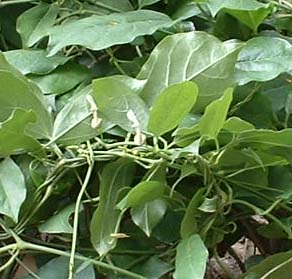
English name: Indian birthwort.
Sanskrit name: Ishvari.
Vernacular names: Ben and Hin : Isharmul; Mal: Isvaramuli; Mar: Sapasan; Tel: Eswaramuli.
Trade name: Iswarmul.
Traditional use: Root: tonic, stimulant, emetic, emmenagogue, in fever, in powder form is given with honey for leucoderma; Root-decoction: in impotency; Crushed root: applied on itching; Juice of leaf: in snake bite, used for cough; Seed: inflammations, biliousness and dry cough.
UNANI: a constituent of 'Majnoon-e-Flasfa'.
Modern use: Plant: used as abortifacient; EtOH (50%) extract: diuretic and antiinflammatory; Dried stem and root: used as drug, which should be used in minimal doses; the drug promotes digestion and controls menstruation; in higher doses, it may prove lethal, it is used as a stimulant, tonic and for fevers; in moderate doses, it is used as a gastric stimulant and in dyspepsia; Root: considered as a stimulant, tonic and emmenagogue and also used in intermittent fever and in bowl troubles of children; shows antifertility activity in experimental animals.
Phytography : Twining herb, semiwoody, having more or less swollen nodes; leaves cordate or ovate, exstipulate; flowers irregular, often offensively smelling, perianth globose with a purple dilated and trumpet-shaped mouth with a strap-shaped brown purple appendage or lip behind; fruit a subglobose capsule.
Phenology: Flowering: June to October; Fruiting: November to March.
Distribution: Found throughout the subcontinent, mainly in the plains and lower hilly regions from Nepal to Bangladesh.
Ecology and cultivation: Found in open scrub jungles; wild.
Chemical contents: Root: a crystalline substance-probably a glucoside, a micro-crystalline principle glucosidic in nature named isoaristolochic acid, allantoin, 0.05% carbonyl compounds and a small amount of an oil, with the odour of isovanillin, ishwarone, ishwarane, aristolochene.
Top Home
Asparagus racemosus Willd. var. javanicus Baker (Liliaceae)
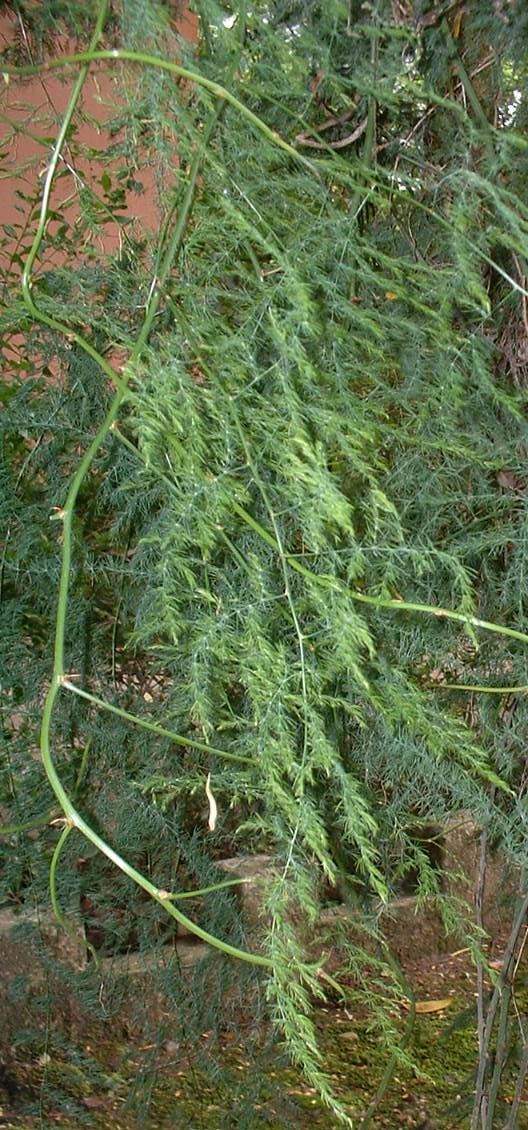
Syn : Asperagus tetragonus.
English name: Asparagus.
Sanskrit names: Shatavari, Shatamuli.
Vernacular names: Asm : Shatamul; Ben: Shatamuli; Guj : Satawari; Hin : Shakakul, Sada bori, Shatamuli, Satwar; Mal: Shatavali; Mar: Shatavari, Shatavarimul; Ori : Shatamuli; Tam: Chattavari, Cadumullam, Shimai shadavari; Tel :Challagadda.
Trade names: Shatamuli, Asparagus.
Traditional use: SOME TRIBES OF INDIA: Root: refrigerant, antiseptic, alterative and galactogogue; roots form a constituent of medicinal oils used for nervous and rheumatic complaints; powder boiled with milk and sugar has been used in different types of neurological disorders, urinary calculi; rub the root of the plant in different diseases of urinary organs; Powder of leaf: enhances breast milk, used for the treatment of colon syndrome.
AYURVEDA : useful in different types of cardiac abnormality; beneficial for intelligence as well as on memory modulatory; Powder of root (boiled with milk) : for treatment of night blindness; .
UNANI : Ingredient of 'Satawar'.
Modern use: Root: used as demulcent, aphrodisiac, diuretic, antidysenteric, in impotency, azoospermea.
Phytography : A slender, scrambling/scandent suffruticose perennial, woody, prickly shoots with reflexed spines; cladode more or less acicular and triquetrous falcate 13-26 mm long; divaricate, finely acuminate; flowers white, sweet-scented, :t 6 mm on filiform articulate pedicels, 6-12 mm long in very short racemes; berries 2.5-6 mm in diameter, scarlet, red on ripening.
Phenology: Flowering: September-December; deciduous or dying back to the root in the hot season; Fruiting: throughout the year.
Distribution: Throughout tropical and subtropical regions of the country,
Ecology and cultivation: Common in scrub jungles and in forests; cultivated as ornamentals.
Chemical contents: Leaf: quercetin-3-glucoronide, sitosterol, stigmasterol, sarsasapogenin, sito-sterol D-glucoside, stigmasterol-B-D-glucoside, two sirostanolic and two furostandic saponins.
Remark: Root is used in veterinary medicine.
Top Home
Bacopa monnieri (L.) Pennel (Scrophulariaceae)

Syn: Herpestis monniera (L.) H.B. & K., Moniera cuneifolia Michx., Gratiola monniera L.
English name: Thyme leaved gratiola.
Sanskrit names: Brahmi, Nira brahmi.
Vernacular names: Ben
Adhabirni, Birmi shak, Barmi shak, Brahmi; Hin : Barambhi, Safed chammi; Mal: Nir bramhi; Mar: Barna; Ori : Urishnaparni; Tam: Nirbrami; Tel: Sambranichettu.
Trade name: Brahmi.
Traditional use: ATHARVA VEDA: strengthens body, improves quality of semen; CHARAKA SAMHITA : invigorating, life sustaining; SUSHRUTA SAMHITA : increases memory and lifespan; AYURVEDA: (a) Plant: bitter, diuretic, blood-purifier, invigorates sex; (b) Plant-extract: used in purification of blood, for anaemia, dermatitis, diabetes, filaria; (c) Plant-juice (along with ginger, sugar and bark extract of Moringa oleifera) : to children in stomach disorder; (d) Leaves (fried in ghee) : as a brain tonic, in nervous weakness, hysteria, epilepsy, insanity, anxiety neurosis, and to sharpen dull memory.
AGNI PURANA: Plant: poison-killer; Plant-juice: good for epilepsy. UNANI: invigorating and good for cold and cough.
Modern use: Plant-extract: In experiments with mice, rat and dog, it has been proved to be tranquilizer, musculature relaxant, antispasmodic, anticancer; Powdered dried leaf: satisfactory results obtained in man in cases of asthenia, nervous breakdown, and other low adynamic conditions.
Phytography : Annual creeper, rooting at each node; stem soft, succulent, soft hairs present; branches 10-25 cm long; leaves alternate, simple, 1.25-1.8 cm long, sessile or subsessile, oval-shaped; flowers light blue or white, 0.8-1.5 cm long; capsules 2- grooved, valves separating from entire column, many-seeded.
Phenology: Flowering: April-June; Fruiting: June-December.
Distribution: Marshes throughout India, ascending up to 1300 m; Bangladesh, Pakistan and Sri Lanka.
Ecology and cultivation: Grows in damp or marshy areas, on the banks of ponds and canals, in the crop fields.
Chemical contents: Plant: Becoside A & B, betulic acid, betulinic acid, d-mannitol, stigmasterol, β-sitosterol, saponin, stigmastanol, hersaponin, monnierin, nicotine, luteoline and its glucosides.
Top Home
Balanites aegyptica (L.) Delile ( Balanitaceae)
 Delile.jpg)
Syn : Balanites roxburghii Planch, B. aegyptica var. roxburghii Duthie.
English names: Desert date, Soapberry tree, Thorn tree.
Sanskrit name: Ingudi.
Vernacular names: Ben and Hin : Hingan; Mar: Hinganbet; Tam: Nanjunda; Tel: Gari.
Trade name: Hingan.
Traditional use : TRIBES OF PANCH MAHAL (Maharashtra) and RURAL FOLK: Bark, Leaf, Fruit and Seed: as anthelmintic and purgative; Fruit: in boils, leucoderma and other skin diseases; Fruit-pulp: in whooping cough.
Modern use: Plant: cytotoxic and antitumour principle isolated; Bark: bactericide; EtOH (50%) extract of bark: spasmolytic; Seed-kernel oil: antimicrobial, useful in burns and ulcers, spermicidal.
Phytography : Spiny tree, about 6 m high; branches glabrous or puberulous and ending in very strong ascending spines; leaves alternate, bifoliate, ashy green, leaflets coriaceous; cymes axillary, 4- to 10-flowered; flowers green, velvety pubescent; fruits ovoid, about 5 cm in length, fleshy drupes, 1-seeded; seed oily but exalbuminou8
Phenology: Flowering: November, also during February to May; Fruiting: Winter.
Distribution: Bihar, Deccan, Gujarat, Uttar Pradesh (Kanpur) and Sikkim.
Ecology and cultivation: Xerophyte, found chiefly on black cotton soil; does not thrive in rocky areas.
Chemical contents: Plant: diosgenin and yamogenin; Root: steroidal sapogenin, diosgenin, yamogenin; Stem-bark: steroidal sapogenin, nitrogen glucoside, sesquiterpene, balanitol, bergapten; Leaf: 6 diosgenin glucosides; Fruit: steroidal sapogenin, yamogenin, 5 diosgenin glycerides, 6 diosgenin glucosides, diosgenin, balanitisins A, B, C, D & E; Seed: a saponin of diosgenin, non-edible fatty oil.
Remarks: Fruit-pulp is edible and used for cleansing silk and cotton. Fruit-shell is used in fire-cracker industry. Wood is chiefly used for making walking sticks and as fuel.
Top Home
Bauhinia vahlii Wt. & Arn. (Caesalpiniaceae)
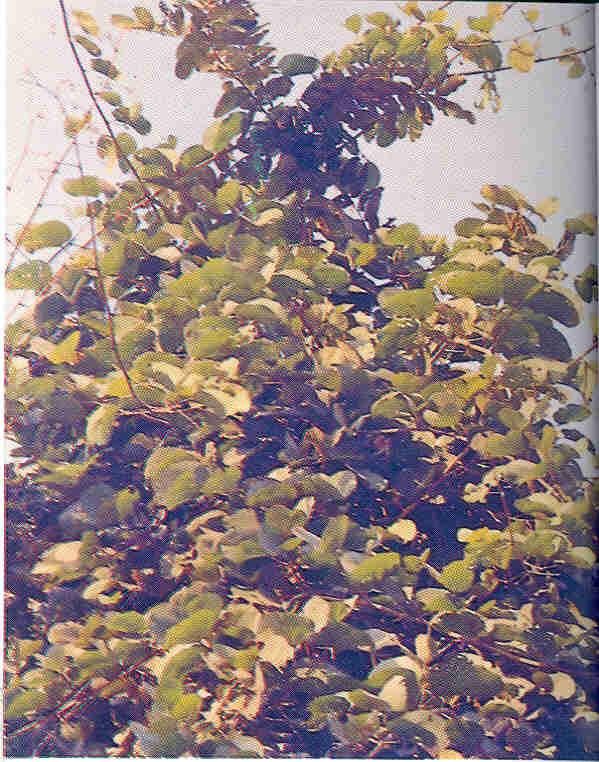
Syn : Phanera vahlii Benth.
Vernacular names: Ben: Sehari; Lod : Jom-Iar; San: Sihari-chop.
Traditional use: TRIBES OF TEHRI-GARHWAL : (i) Fruit: aphrodisiac, (ii) Seed: tonic and vermifuge; TRIBES OF BASTAR : (i) Seed: tonic; SANTAL: (i) Plant: in dysentery, stomachache, (ii) Fruit: to treat antifertility of women.
Phytography : Huge climber with many tendrils; branch lets hairy; leaves alternate, petiolate, simple, 2-cleft, cleavage goes down a quarter to one-third way from the apex, 7.5-45.0 cm long; racemes terminal, subcorymbose; flowers bracteate, 2.5 cm long; pods nearly 45 by 5 cm, rusty-downy, 7- to 12-seeded.
Distribution: Foot of central and eastern Himalaya, ascending up to 800 m, Bihar, Madhya Pradesh, Maharashtra and Karnataka.
Top
Butea monosperma (Lamk.) Taub. (Fabaceae)

Syn : Butea frondosa Roxb., Erythrina monosperma Lamk.
English names: Flame of the forest, Parrot tree.
Sanskrit name Palasha.
Vernacular names: Asm and Ben: Palash; Guj : Khakar; Hin : Dhak; Kan : Muttugathoras, Muttugu-mara; Mal: Chamath, Khakar; Mar: Palash; Mun : Murud ba; Orn : Murka; Ori: Palasa;. Pun: Dhak; Sad: Pal as, Paras; Tam: Samithu, Palasam; Tel: Moduga, Palashamu.
Trade names Palasha, Dhak.
Traditional use: KHASI and GARO : Leaf: in delirium; TRIBES OF PURULIA (West Bengal) : Seed: in ascaris; TRIBES OF MA YURBHANJA (Orissa) : Seed: as contraceptive; TRIBES OF SANTAL PARGANAS (Bihar) : Root: in tuberculosis; TRIBES OF VARANASI (Uttar Pradesh) : Leaf: in boils; Seed: as vermifuge; TRIBES OF MIRZAPUR (Uttar Pradesh) : Bark: in dysentery; Gum: in diarrhoea, dysentery; TRIBES OF SIWALIK (Uttar Pradesh) : Gum: as tonic; BHAT: Seed: as abortifacient; BHOXA: Bark: in bone fracture, Gum: in piles, urinary complaints; GARHWALI: Leaf: in boil, inflammation, Flower: in diarrhoea, dysentery, pimples, Seed: as anthelmintic; THARU: Gum: as diuretic, Seed: as cooling agent; FOLKS OF DELHI: Gum: as astringent, Flower: as aphrodisiac, astringent, diuretic, Seed: as anthelmintic; FOLKS OF KURUKSHETRA (Haryana): Flower: in stomachache; DANG: Bark: in diarrhoea; TRIBESOFRATANMAHAL HILLS (Gujarat) : Flower: in eye complaints; KORKU (of Maharashtra): Flower, in dysentery; TRIBES OF KHANDLA (Maharashtra) : Flower: in dog bite, urinary complaints; TRIBES OF CHANDRAPURA (Maharashtra) : Leaf: in skin diseases; TRIBES OF JHABUA (Madhya Pradesh) : Root: in dog bite; TRIBES OF SAGAR (Madhya Pradesh): Leaf: as vermifuge, Flower: in diabetes, diarrhoea, piles; TRIBES OF EAST GODAVARI (Andhra Pradesh) : Gum: in diarrhoea; TRIBES OF NILGIRI (Tamil Nadu) : Bark: as haemostatic, in wounds, Flower: in eye complaints; TRIBES OF KANNANORE (Kerala): Flower: in antifertility.
ATHARVA VEDA: Extract of stem: beneficial for sperms and helps securing conception; CHARAKA SAMHITA : Stem-extract: useful in leprosy, piles, gastroenteritis and menorrhagia; SUSHRUTA SAMHITA : useful in diseases caused by vayu (wind), Seed: effective against intestinal worms; A YURVEDA : Bark: useful against snake venom, wounds, indigestion, gastroenteritis, fever, tuberculosis, Gum: astringent, beneficial to children and women, Leaf: astringent, sex stimulant, useful in intestinal worms, dyspepsia, piles, menorrhagia, pimples, wounds in mouth/throat, Flower: diuretic, sex stimulant, helps menstruation, useful in gastroenteritis, Seed: useful against intestinal worms.
SIDDHA : Flower-juice: used in preparation of the medicine Murukkam, Seed and Kernel: in Palac
UNANI: Ingredient of the medicine called 'Dhak(tesu)' and 'Samaghke Dhak'.
Modern use: Plant (alcoholic extract: produces persistent vasodepression in cats, shows activity against earthworms; Bark: insecticide against house flies; Alcohol extract of bark : inhibitory against E. coli and Micrococcus pyogenes var. aureus; Gum: solution applied to check conception; Root (bark) : aphrodisiac, analgesic, anthelmintic, useful in elephantiasis, applied in sprue, piles, ulcers, tumours and dropsy; EtOH (50%) extract of leaf: spasmogenic; FlolYer: effective in leprosy, gout; Alcoholic extract: antiestrogenic in mice; Aqueous extract: anti-implantation in rats; along with Hygrophila auriculata leaf and root taken with milk to cure leucorrhoea; Seed (freshly powdered) : effective against Ascaris; Extract (in vitro) : anthelmintic against Asacridia galli worms; finely powdered along with Acorus calamus rhizome or mixed with juice of Cyperus rotundus rhizome: cures delirium; Saline extract: agglutinates erythrocytes of animals; Hot alcoholic extract: anti-implantation and anti-ovulatory in animals.
Phytography : Erect tree, reaching a height of 13-17 m; young stem clothed with grey or brown silky hairs; leaves alternate, petioles 7.5-15.0 cm long, trifoliate, leaflets 10-20 cm long, leathery, lower surface covered with dense silky hairs; racemes 15 cm long; flowers bright orange-red, thickly clothed on the outside with silvery small hairs; pods 15-20 cm by 3.7-5.0 cm, narrowed suddenly into a stalk longer than calyx.
Phenology: Flowering: February-April; Fruiting: May-July.
Distribution: Plains of India, ascending up to 1300 m; Myanmar.
Ecology and cultivation: Mesophyte; wild.
Chemical contents: Plant: flavonoids, glucosides, butin, butrin, isobutrin, palastrin; Flower: butrin, coriopsin, monospermoside, sulphurein, chalcones; Seed: palasonin, Seed oil: d-Iactone of n-heneicosanoic acid, monospermine, new phytolectin.
Remarks: An important tree for lac cultivation, but the lac produced on it is of inferior quality. Bark yields fibre, wood yields timber of poor quality; stem-bark used as fish poison by tribes of South Rajasthan. Plates and bowls are made by stitching the leaves by the tribes of Purulia and Saurashtra. Flowers yield a yellow dye of little permanency.
Flowers are eaten as vegetables by tribes of Manbhum and Hazaribagh Districts of Bihar while fruits by Garhwalis.
Tree is sacred to the Hindus and Buddhists. Flower is an essential item of Saraswati Puja.
Top Home
Careya arborea Roxb. (Lecythidaceae)
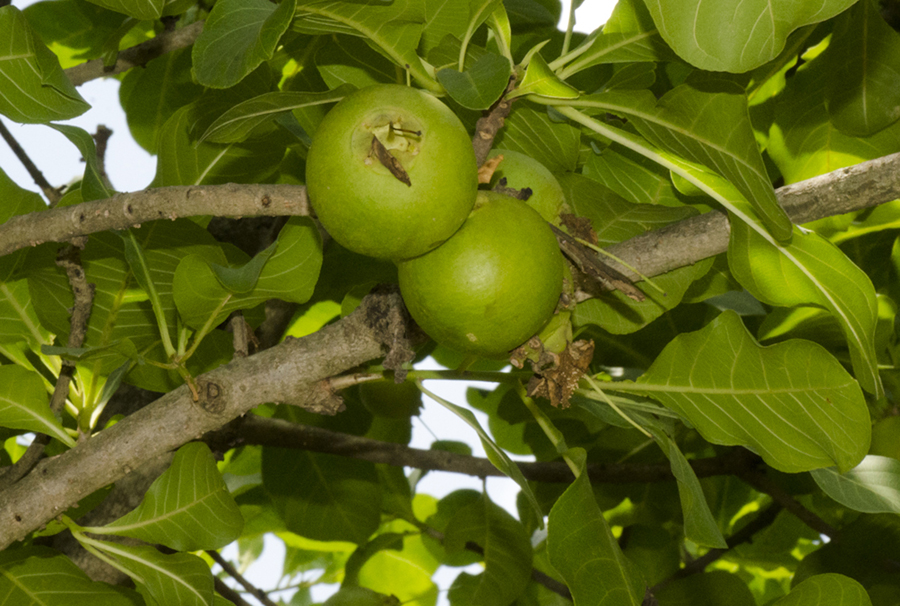
English name: Tummy wood.
Sanskrit name: Kumbhi.
Vernacular names: Ben and Hin : Kumbhi; Guj : Kumbi; Kan : Kaval, Doddala, Asanda; Lod : Kumbi-daru, Kumbhi; Mal: Alam, Pelu; Mun : Asanda-daru, Kumbhir; Sad: Kumbi; San: Khubati; Tam: Ayma; Tel: Araya, Duddipa.
Trade names: Kumbhi, Kumbi.
Traditional use: LODHA: (i) Root-paste: in body pain, (ii) Root-bark decoction (with long pepper) : in fever, (iii) Stem-bark powder (paste with honey): to children in cold and cough; SANTAL : Stem-bark: (paste with margosa) : in leucoderma
Phytography : Medium-sized tree with large ovate, ovate-oblong leaves clustered at the end of the branchlets, old le_ves often red/purple; flowers large, white and pink, in dense spikes, fruits large globose green, crowded with calyx tube, deciduous.
Phenology: Flowering: March-May; Fruiting: July.
Distribution : Sub-Himalayan tract occurring throughout India up to an elevation of 1700 m.
Chemical contents: Bark: lupeol, betulin; Leaf: ellagic acid, hexacosanol, quercetin, β-sitosterol, β-spinasterol taraxerol and its OAc, valoneic acid, careaborin, β-amyrin; Seed: α-spinasterol, α-spinasterone, baringtogenol-C, careyagenol-E.
Remarks: Only plant named by William Roxburgh in honour of William Carey. Lodhas use fresh stem bark decoction for washing septic wounds of cattle, and keep a dry fruit in a room as snake repellant. Oraons use powdered stem, root and leaf for poisoning fish.
Top Home
Catharanthus roseus (L.) G. Don (Apocynaceae)
 G_ Don.jpg)
Syn: Lochnera rosea (L.) Spach, Vinca rosea L.
English names: Madagascar periwinkle, Old maid, Red periwinkle.
Vernacular names: Ben: Nayantara; Hin : Sada sawagon; Lad: Swet chandu; Mal: Ushamalari; Mar: Sadaphul; Ori : Ainskati; Pun: Rattanjot; Tam: Sudukadu Mallikai; Tel: Billaganneru.
Trade name: Nayantara.
Traditional use: BODO: (i) Plant: in cancer, diabetes, (ii ) Leaf: in menorrhagia; LODHA : (i) Root-paste: in septic wounds, (ii) Root-decoction (with paste of long peppers) : in fever, (iii) Leaf-juice: in blood dysentery, (iv) Leaf-decoction: to babies in gripping pain; SANTAL : (i) Latex: in scabies, (ii) Seed-powder (with decoction of black pepper) : in epilepsy; ETHNIC COMMUNITIES OF EAST GODAVARI DISTRICT: Root: in cancerous wounds.
Modern use: Plant-extract: antimitotic; Root (alkaloids) : in cancer, and as emetic, hypotensive, sedative and antiviral.
Phytography : A small herb or subshrub, up to 75 cm high; leaves elliptic-ovate to oblong, 4-10 by 2-4 cm, glabrous to puberulous, base acute or cuneate, apex obtusely apiculate, lateral nerves 10-12 pairs, petiole 1.0-1.5 cm; flowers in axillary or terminal cymes; solitary or paired, shortly pedicellate, pink or white or white with pink or yellow ring in orifice region; mericarps 3-4 by 0.3 cm, puberulous.
Phenology: Flowering and Fruiting: throughout the year.
Distribution: A native of West Indies; commonly grown in gardens throughout India;
Bangladesh and Pakistan.
Ecology and cultivation: Plains from the coasts, in wastelands, fallow fields, less on the hills 800-1400 m, also widely cultivated.
Chemical contents : Root-bark: vincaline I & II; Root: vinblastine or vinleukoblastine (VLB), vincristine or vinleurocristine (VCR), ursolic acid, oleanolic acid, ajmalicine, alstonine; Stem: vinca rodine, vincoline, vinamidine,leurocolombine, vincathicine, vincubine; Leaf: leurosine, vindoline, catharanthine, lochnerine, tetrahydroalstonine, roseoside, essential oil; Seed: vincedine, vincedicine, tabersonine.
Top Home
Costus speciosus (Koening ex Retz.) J.E. Smith (Zingiberaceae)
 J_E_ Smith.jpg)
Syn : Banksea speciosa J. Koening
Sanskrit names: Canda, Kemuka.
Vernacular names: Ben: Keu; Hin : Kebu, Keyu, Kusi; Kan : Chengaivakoshtu; Mal: Cannakilannu, Cannakkuvva, Narumeanna; Mar: Penva, Pushkarmula; Tam: Kostam, Kuiravam, Kottam; Tel: Chengaivakohtu.
Trade name: Keyu.
Traditional use: Rhizome: bitter, astringent, acrid, cooling, purgative, aphrodisiac, anthelmintic, depurative, febrifuge, expectorant and tonic, also beneficial in asthma, anaemia, bronchitis, leprosy, flatulence, constipation, fever, skin diseases and inflammation.
Modern use: in carcinogenic tumours.
Phytography : Succulent perennial herb with long leafy spirally twisted stems, 2-3 m high and horizontal rhizomes; leaves simple, spirally arranged, oblanceolate or oblong, glabrous above, silky pubescent beneath with broad leaf sheaths; flowers white, large, scented, in large terminal spikes; bracts bright red; fruits globose / ovoid capsules; seeds obovoid or semiglobose.
Phenology: Flowering: September-October; inflorescence globose of closely packed bracts.
Distribution: Throughout India; Pakistan and Bangladesh-in moist localities and in wastelands.
Ecology and cultivation: Hills above 800 m; moist places and wastelands also.
Chemical content: Root: rich in starch.
Top Home
Curcuma longa L. (Zingiberaceae)
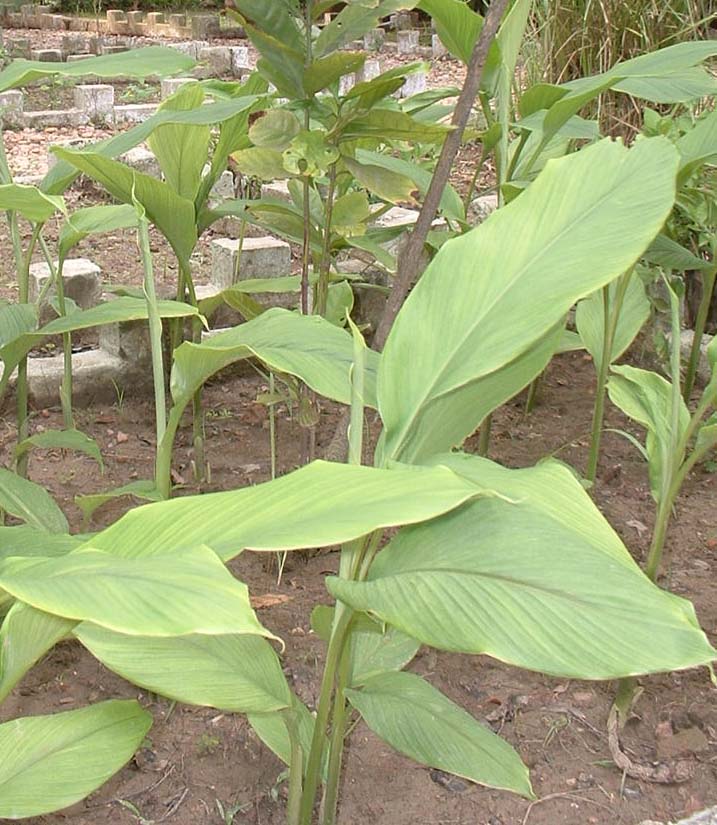
Syn : Curcuma domestica Val.
English name: Turmeric.
Sanskrit name: Haridra.
Vernacular names: Asm : Holodhi; Ben: Halud; Guj : Halada; Hin : Haldi; Kan : Arisina; Kon : Holldi, Ghor hollad; Mal: Manjella-kua; Mar: Halede; Mun : Hatu sasang, Sasang; Orn: Balka; Ori : Haladi; Sad: Haldi; San: Oerel sasan; Tam: Manjal; Tel: Pasupu.
Trade name: Haldi.
Traditional use: ETHNIC COMMUNITIES OF ARUNACHAL PRADESH AND ASSAM: Rhizome: in migrain; SANTALS : (i) Rhizome: in hazy vision, inflammation of eye, night blindness, subnormal temperature after fever, spleen consumption, Basli rog (pain similar to rheumatism), rheumatism due to draught, lock-jaw, Rosbi (stealth convulsions with indistinct speech), chronic scabies, sores and curbuncles, infantile atrophy, indigestion, prolapsus ani and fistula ani, bronchitis, cough and cold, puerperal fever; (ii) Extract of Rhizome: in rhagades; (iii) Bulb: in drying up of lactation; (iv) Flower: in cholera, sores in throat, syphilis; (v) Dried Flower: in icterus; ETHNIC COMMUNITIES OF RANCHI and HAZARIBAGH(Bihar): (i) Leaf: in cold, fever, pneumonia; GARHWALI: Rhizome: in pimples and feckles on face, wounds, leprosy; KUMAONI : Rhizome: in cough, insect stings, wounds; ETHNIC COMMUNITIES OF KURUKSHETRA (Haryana) : Rhizome: in body pain, headache; TRIBES OF ARAKU VALLEY (Andhra Pradesh) : Rhizome: as anthelmintic..
RIGVEDA : Rhizome: improves body complexion and apetite; YAJURVEDA : Rhizome: is a blood-purifier, improves body complexion; CHARAKA SAMHITA : laxative, useful in leprosyand against contaminuos microbes; SUSHRUTA SAMHITA : digestive; AYURVEDA : Rhizome: effective against bacterial infection, skin diseases, intestinal worms, liver complaints, stammering, filaria, asthma, sprain, boils, wounds, conjuctivitis, thirst due to phlegm, allergic reactions, against leeches, .minor ingredient of a drug for malarial fever.
SIDDHA : Rhizome: ingredient of Kappu mancal, Manchal.
UNANI : ingredient of 'Majnoor-e-falsfa', useful in gastrointestinal complaints; Powder of rhizome: used as antifertility agent.
Modern use: Rhizome: ingredient of 'Geriforte'-effective in senile pruritis, Vitafix -useful in premature ejaculation, insect repellent against houseflies, insecticide, antifungal; EtOH (50%) extract of rhizome: antiprotozoal, spasmolytic, hypotensive, Central Nervous System depressant; daily consumption of 1 gm raw rhizome helps to fight decaying metabolism and thus prevents cancer; Essential oil from rhizome: antiarthritic, antifungal,. anti-inflammatory, antibacterial.
Phytography : Herb with large ovoid rootstock, sessile tubers thick, cylindric, bright yellow inside; petiole 60 cm long, leav.es green, 30-45 cm by 10-20 cm; peduncle 15 cm or more long, hidden by sheathing petiole, spikes 10-15 cm, about 5 cm in diameter; bracts pale green, ovate, about 3.7 cm long, those of the coma pale pink; flowers yellow, as long as the bracts.
Phenology: Flowering: Autumn.
Distribution: Indigenous to Paresnath (Bihar); widely cultivated in West Bengal and other parts of India; Bangladesh, Sri Lanka.
Ecology and cultivation: Tropical plant; cultivated throughout the tropics. Chemical contents: Essential oil from rhizome: curcumin.
Remarks: In Hawaii, rhizome is used against growth of nostrils, for cleaning blood and as gargle; green rhizome is given for whooping and other coughs. In Sri Lanka, Rhizome paste is used in skeletal fracture. Extensive research is being carried out on the nutritional and medicinal value of this plant.
Top Home
Datura metel L. (Solanaceae)
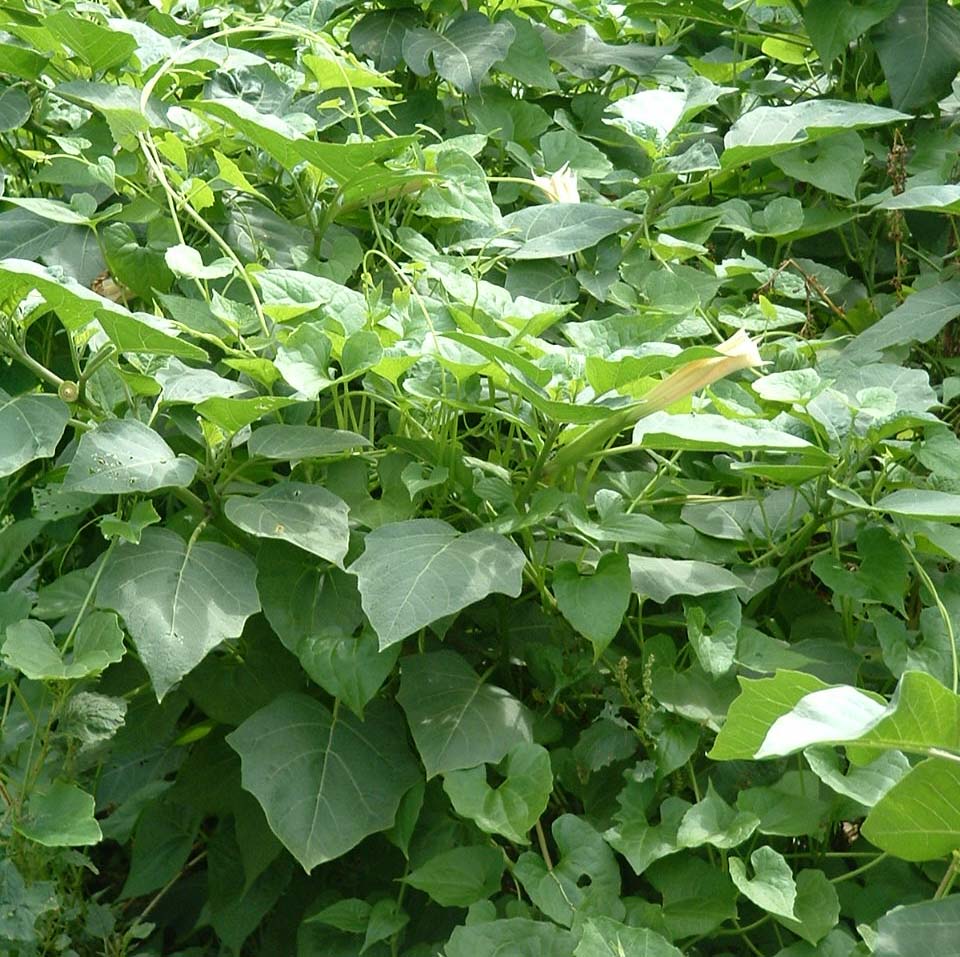
Syn : Datura alba Nees, D. fastuosa L. var alba C.B. Clarke
English name: Hindu datura.
Sanskrit name: Dhustura.
Vernacular names :Ben: Dhutra, Dhatura; Hin : Sadahdhatura; Tam: Vellum mattai. Trade name: Dhutra.
Traditional use: FOLKS OF PURULIA (West Bengal and Rajasthan: Seed: for treatment of leprosy; FOLKS OF RAJASTHAN: Leaf: in guinea-worms; Other uses of seed, leaf and root: in insanity, fever with catarrhal and cerebral complications, diarrhoea, skin diseases and antideptic. It is narcotic, acrid, anodyne, antispasmodic, intoxicating, emetic and useful in asthma; Root: used for treatment of bites from rabbits; Poultice made of leaf: used for epilepsy, ophthalmodynia, otalgia, lumbago, sciatica, neuralgia, mumps and painful swelling.
Modern use: Seed: aphrodisiac, narcotic and antispasmodic and useful in dontalgia, otalgia, gastropathy and skin diseases and for treatment of dandruff and lice; EtOH (50%) extract of plant: anticancer, anthelmintic, spasmogenic and blood pressure depressant; Aquous extract of plant: nematicidal; Leaf extract: antiviral; EtOH extract of leaf and aquous extract of fruit: anticholinergic.
Phytography : Coarse annual herb, may be 2 m tall, stem scented; leaf alternate, petiolate, simple; flowers axillary, peduncled, white or nearly so, 17.5 cm long and may be 12.5 cm in diameter across the mouth; capsules subglobose, 3 cm in diameter, equally spinous on all sides.
Phenology: Flowering: throughout the year; Fruiting: with blunt spines.
Distribution: Throughout India; occasionally grown in gardens.
Ecology and Cultivation: Hills up to 1500 m, occasionally in the plains even to the coast; wild.
Chemical contents: Root: alkaloids, tropane derivatives; Stem: hyoscine, hyoscyamine, Leaf: hyoscine, hyoscyamine, micotianamine; Fruit (pericarp) : alkaloids, β-sitosterol, triterpene, daturaolone, daturadiol; Seed: hyosane, hyoscyamine, daturaolone, fastusic acid; Seed-oil: β-Me-sterols.
Top Home
Dillenia indica L. (Dilleniaceae)

Syn : Dillenia speciosa Thunb.
English name: Dillenia.
Sanskrit names: Bhavya, Bharija.
Vernacular names: Asm : Chalita, Qutenga; Ben: Chalta; Guj : Karambel; Hin : Chalta; Kan :Betta kanijala; Mar: Mota karmal; Mal: Chalita, Punna; Man: Heigri; Ori : Qu, Uvu; San: Korbhatta; Tam and Tel: Uva.
Trade name: Chalta.
Traditional use: MANIPURI : Fruit decoction: for curing dandruff and checking falling of hairs; MIKIR (Assam) : Fruit: eat to combat weakness; TRIBES OFTEJPUR (Assam) : Plant: in fever; TRIBES OF TlRAP (Arunachal Pradesh) : Leaf: in dysentery; SANTAL : (i) Root: as prophylactic at the cholera season, an ingredient of a medicine for burning sensation in the chest; (ii) Stem-bark: component of medicine for sores caused by mercury poisoning, chronic progredient sores and carbuncle, and as a prophylactic at the cholera season; (iii) Mucilage: on wounds of burns; TRIBES OF ABUJH MARH RESERVE AREA (Madhya Pradesh) : Fruit: as tonic; TRIBES OF EAST GODAVARI (Andhra Pradesh) : Fleshy calyx: in stomach disorders.
YAJURVEDA : an important plant; UPAVARHANA SAMHITA : the plant is aphrodisiac and prpmotes virility; CHARAKA SAMHITA : the fruit is sweet, acidic, astringent, removes bile, phlegm, fetid and flatulence; SUSHRUTA SAMHITA : fruit cardiotonic, tasteful, astringent, acidic, removes bile, phlegm, fetid and flatulence; RAJANIGHANTU: green fruit is acidic, pungent, hot, removes wind, phlegm, but the ripe fruit is sweet, sour, appetising and beneficial in colic associated with mucous; MATSYA PURANA : decoction of this plant can be used as universal antidote for poison; AGNI PURANA : spraying water, containing stem extract, on and around the wound caused by spider bite helps in removing the poison.
AYURVEDA: (i) Root (bark extrac_: in food poisoning; (ii) Root-bark(paste): along with leafpaste applied externally in sprains; (iii) Young bark and Leaf: astringent; (iv) Fruit-juice : mixed with sugar and water serves as a cooling beverage in fever, fit, and as a cough syrup; (v) Ripe fruit-juice: removes flatulence, increases quantity of semen, galactogogue, combats weakness, external application helps supuration of boil, and checks loss of hair. Modern use: Leaf (50% EtOH extract) : shows antiamphetamine activity; Seed-extract: antimicrobial; Seed-oil: antifungal, and its unsaponifiable matter antibacterial.
Phytography : Evergreen, round-headed tree, 9-42.5 m high; branchlets tomentose, bark cinnamomum-like; leaf alternate, simple, fascicled at the apices of branches, petiole 3.7 cm long, lamina 20-25 cm by 5-10 cm, oblong-Ianceolate, closely set parallel veins from midrib, upper surface glabrous, hairs present on the lower surface, especially on veins; flower terminal or leaf-opposed, solitary, white, 15 cm in diameter, sepals thick; fruit globose with accrescent calyx, 12.5-15 cm in diameter, green when young, yellowish and sweet-scented when ripe; seeds many, compressed, embedded in hairy cells.
Phenology: Flowering: May-June; Fruiting: July-August. - ripens in NovemberDecember.
Distribution: Sub-Himalayan tract from Garhwal to Assam, Arunachal Pradesh, Manipur, Tripura, West Bengal, Orissa, Bihar, Central and South India; Nepal, Bangladesh, Sri Lanka.
Ecology and cultivation: Plant of tropical forest; occasionally grown in gardens.
Chemical contents: Stem-bark: betulin, betulinaldehyde, betulic acid, flavonoids, dillentin, dihydroisorhamnetin, lupeol, myricetin, glucosides, B-sitosterol; Wood: betulinic acid, lupeol, β-sitosterol; Leaf: betulinic acid, cycloartenone, flavonoids, n-hentriacontanol, Bsitosterol; Fruit: an arabinogalactan, betulinic acid, β-sitosterol.
Remark: Green calyx is eaten in various forms of pickles.
Top Home
Dioscorea bulbifera L. (Dioscoreaceae)
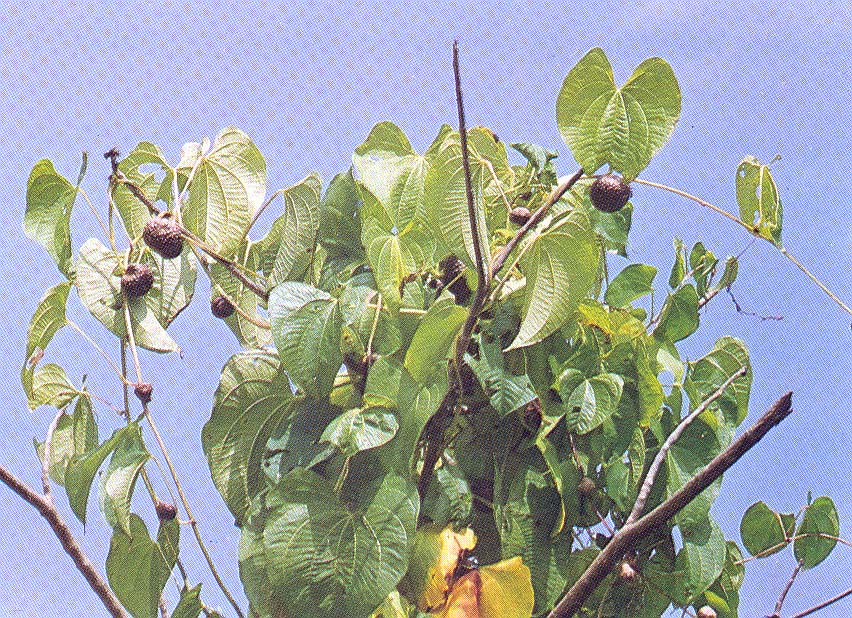
Syn : Dioscorea crispata Roxb., D. pulchella Roxb.. D. sativa Thunb. non L, D. versicolor Buch. Ham.
English names: Air yam, Potato yam, Air potato.
Sanskrit name: Varahi.
Vernacular names: Ben: Banalu, Kukuralu; Hin : Gaithi, Rataler, Pitalu; Kan : Heggenasu; Man: Ha; Mar: Manakundu, Karukarinda; Mun : Jo aru; Tam: Kodikulangu; Tel: Chedupaddu-dumpa; San: Bongo-sanga.
Traditional use: TRIBES OF PURULIA (West Bengal) : Tuber: in boils; SANTAL : (i) Dried tuber (powdery: as shampoo and on sores; (ii) Plant: against madness; SIKKIMESE : Tuber: in jaundice; ETHNIC COMMUNITIES OF DEHRA DUN AND SIWALIK: Tuber: in dysentery, piles; DANG (Gujarat) : Tuber: in abdominal pain, bone fracture.
Modern use: Aerial parts (50% EtOH extract) : diuretic; Rhizome: anorexiant.
Phytography : Climber, usually twining to the left; stem slender, green or purple, with 10-15 small crisped wings, tubers large, variable in form; leaves opposite and alternate, petioles 5-15 cm long, lamina cordate, very variable in size, attaining 35 cm in length, membranous, dark green, 7-9 costate; male spikes slender, almost capillary, 2.5-10 cm long, panicled, flowers crowded or scattered, green or purplish; female spikes 10-25 cm long, pendulous; capsules 1.6-2.5 cm by 0.8-1.25 cm, membranous; seeds with broad basal wing.
Phenology: Flowering: August-September; Fruiting: November.
Distribution: Common in the outskirts of forests throughout India, ascending up to 2000 m in the hills; Bangladesh, Pakistan.
Ecology and cultivation: Plant of tropical climate, grows in the midst of scrub jungles, rare; wild and planted.
Chemical contents: Tuber: furanoid norditerpenes, norditerpene glucosides, diosbulbinoside D & F, diosbulbin B & D, a new dihydrophenanthrene, d-sorbitol; Bulbil: diosgenin.
Remarks: Tubers are eaten as vegetable by the ethnic communities of Meghalaya, Kameng district of Arunachal Pradesh, Purulia and Medinipur districts of West Bengal, Varanasi, Mirzapur districts and Kumaon area of Uttar Pradesh, Madhya Pradesh, Goa, Maharashtra, Ratan Mahal Hills (Gujarat), Rajasthan, Cannanore district of Kerala and Mikirs (Assam), Santals (West Bengal) and Tharus (Uttar Pradesh).
Boiled bulbils are eaten by Mikirs and Santals as vegetable.
Top Home
Diospyros peregrina (Gaertn.) Gurke (Ebenaceae)
 Gurke.jpg)
Syn : Diospyros embryoteris Pers., D malabarica (Oeser.) Kost.
English names: Gaub Persimmon, Wild Mangostein.
Sanskrit names: Kalaskardha, Krishnasara, Tinduka.
Vernacular names: Ben and Hin : Gab, Kata Gab; Kan : Holetupari; Mal: Panachi; Mar: Tender; Ori : Dhusarokendu, Kendu; San: Makar kenda; Tam: Katlati, Tumbi; Tel : Tinduki.
Traditional use: SANTAL : (i) Root: in gravel; (ii) Bark: in cholera; (iii) Fruit: in dysentery and menorrhagia; TRIBES OF ABUJH-MARH RESERVE AREA (Madhya Pradesh) : Fruit: in dysentery and as tonic; TRIBES OF BASTAR (Madhya Pradesh) : Fruit: in blister in mouth, diarrhoea.
HARIT SAMHITA : Bark: in gastro-enteritis; BAGBHATTA : Juice of unripe fruit: in restoring normal skin colour after burn; BHABAPRAKASA : Aqueous extract of green fruit: in healing burn-wound; BANGASENA : Powder of dried fruit with honey: licking is beneficial in hiccup in children.
AYURVEDA : (i) Bark extract: in chronic dysentery; (ii) Aqueous extract of green fruit: in menorrhagia, excessive salivation.
Modern Use: EtOH (50%) extract of stem and leaf: anticancer, diuretic; EtOH (50%) extract of stem bark: antiprotozoal, antiviral, hypoglycaemic.
Phytography : Middlesized, profusely branched tree; stem and branches black, branchlets glabrous; leaves alternate, petioles ±0.6 to ±0.8 cm long, lamina thick, leathery, oblong, veines slightly elevated above; male flowers in few or many-flowered short cymes, flowers tubular, 0.8 cm long, lobed, calyx black, silky; female flowers solitary or few together, subsessile or cymose, larger than male flowers, ovary 8-celled; fruits usually solitary, subglobose, 2.5-5.0 cm in diameter, brickcoloured when young, yellowish when mature, persistent calyx lobed, accrescent 4- to 8 seeded.
Phenology: Flowering and Fruiting: Summer to rainy season, fruits take 4-5 months to mature.
Distribution Throughout India; Bangladesh, Malaysia and other South-East Asian countries, also in Australia.
Ecology and cultivation: Throughout India, abundant in Bengal; cultivated near habitational sites; occasionally found as ferals; Sri Lanka.
Chemical contents: Root: glycerides; Bark: myricyle alcohol, saponin, triterpenes; Stem: β-sitosterol, α leuconanthocyanin; Leaf: triterpenes; Fruit pulp: alkenes, triterpenes; Seed: betulinic acid, β-amyrin, fatty oil, unsaponified matter.
Adulterants: Often it is confused with Garcinia mangostana and Strychnos nux-vomica. Remarks: Santals use bark in treatment of rinderpest.
Rural people of North Bengal and Bangladesh consume the leaves as vegetable. Fruits are eaten by Bhoxas, Lodhas, Monpas, Santals and Bengalees.
Tribes of Bastar consume the seeds.
Boatmen rub the fruit-juice on the undersurface of boats to protect the wood from rotting, and fishermen use the same in their fishing net for the same purpose.
Top Home
Dolichos biflorus L. (Fabaceae)

Syn : Dolichos uniflorus Lam., Glycine uniflora Dalz.
English name: Horsegram.
Sanskrit name: Kulattha.
Vernacular names: Ben: Kurti-kalai; Hin and Mar: Kutthi; Kan : Hurali; Mal: Muthiva; Man: Nagakrijon; Mun : Kurthi; Orn : Anrsga; Sad: Kurthi; San: Horec; Tam: Kollu; Tel: Ulavalu.
Traditional use: SANTAL : (i) plant: dysuria, sores, tumours; (ii) leaf: in burns; (iii) seed: in adenitis, fistula ani, intercostal neuralgia, pleurisy, pneumonia, prolapsus ani; MUNOA : aqueous extract of seed: to women after childbirth; IRULA, KOTA, TOOA (Nilgiri) : seed: in menstrual complaints; RURAL FOLKS: Aqueous extract of seed: in urinary troubles and kidney stone.
CHARAKA SAMHITA : seed: useful in piles, hiccup, abdominal lump, bronchial asthma, in causing and regulating perspiration; SUSHRUTA SAMHITA . seed powder: useful in stopping excessive perspiration; BAGBHATTA: seed: useful in spermatocalcali (Shukrashman); CHAKRADATTA : decoction of seed: beneficial in urticaria; RAJANIGHANTU : beneficial in piles, colic, epistasis, flatulence, ophthalmia, ulcer.
AYURVEDA : decoction of seed: useful in leucorrhoea, menstrual troubles, bleeding during pregnancy, colic caused by wind, piles, rheumatism, heamorrhagic disease, intestinal worms; seed powder: antidiaphoretic; seed (in combination with milk): work as anthelmintic, soup prepared from seeds is beneficial in enlarged liver and spleen.
SIDDHA : seed: used in preparing a medicine named Kollu.
Modern use: Plant extract: radiolabel reagent in ABa blood grouping of human hair; EtOH (50%) extract of Seed: spasmolytic.
Phytography : Annual herb, trailing or suberect, branched; leaves alternate, stipulate, trifoliate, leaflets membranous, ovate, ±2.5-5.0 cm long, young ones finely pilose; flowers axillary, may be more than one together but without a common peduncle, papilionaceous, usually yellow - may be white, ±1.25-1.8 cm long; pods ±3.7-5.0 cm by 0.6-0.8 cm, recurved, tipped with a persistent style; seeds 5-6 per pod, ellipsoid, flattened.
Phenology: Flowering: August-November; Fruiting: September-December.
Distribution: Widely distributed in India, ascending up to 1000 m in Sikkim; cultivated mainly in Andhra Pradesh, Tamil Nadu, Karnataka.
Ecology and cultivation: Mesophyte; wild and cultivated.
Chemical contents: Stem and Leaf: coumesterol, a lectin-like glycoproticin, psoraliding; Leaf (bacteria treated): dolichin A and dolichin B; Seed : β-sitosterol, coumesterol, delbergiodin, genistein, 2-hydroxy-genistein, isoferreirin, keivitone, phaseollidin, pyranoside.
Adulterant: Cassia abrus L. is sometimes confused with this plant.
Remarks: Santals use the plant in treatment of rinderpest of domestic animals. Seeds are often consumed as pulse. Santals consider eating this pulse is good for patients of dysentery and leprosy, but they prohibit eating this by the patients of measles and small pox.
Top Home
Eclipta alba (L.) Roxb. (Asteraceae)
 Roxb_.jpg)
Syn : Eclipta prostrata (L.) Hassk.
English name: Trailing eclipta.
Sanskrit names: Bhringa, Bhringaraja, Kesaraja, Kayyonni, Markava, Tekarajah. Vernacular names: Asm : Kehoraji; Ben: Bhringaraj, Keshurti, Kesuria, Keshurey; Guj : Bhengra; Hin : Babri, Bhangra, Mocakand, Safed bhannra; Kan : Garga; Mal : Kannunni, Kaiyanni, Kayyonni; Man: Oochisumbal; Mar: Maka; Mun : Bhengaj, Piri kesari; Om : Bhengraj; Ori :Kesarda; Sad: Bhengrait; San: Banda-kansa; Tam: Garuga, Kaikesi, Karipan, Kayyantakara; Tel: Galagara, Guntagalyeru.
Trade name: Kesuth
Traditional use: GARO: Leaf: in gastric troubles, hepatic disorders; MANIPURI : (i) Stem-decoction: in liver enlargement; (ii) Leaf-extract: in fever and cough; TOTO: (i) Whole plant: in hepatic problems, spleen troubles; (ii) Root: in ulcers and wounds; (iii) Leaf: as antidote to scorpion sting; ETHNIC COMMUNITIES OF ORISSA: (i) Plant: in itching; (ii) Leaf: in conjunctivitis and other eye problems, in promoting hairgrowth; SANTAL : (i) Plant-decoction with paste of black pepper: in fever; (ii) Leaf-juice: on wounds; ETHNIC COMMUNITIES OF BIHAR: (i) Plant: against antifertility, (ii) Root: as antidote to snake bite; (iii) Leaf: in malaria and other fevers; ETHNIC COMMUNITIES OF ARAKU VALLEY (Madhya Pradesh) : Leaf: in conjunctivitis, eye troubles; IRULAR: Leaf: in jaundice; TRIBAL SOCIETIES OF ANAIKATTY HILLS (Tamil Nadu): Flower bud: in fever, headache; ETHNIC COMMUNITIES OF SALSETTE ISLAND: Leaf: as cooling; TRIBAL SOCIETIES OF SAURASHTRA (Gujarat): Whole Plant: in asthma, bronchitis, leucoderma; TRIBAL SOCIETIES OF EASTERN RAJASTHAN: Leaf: in sores, ulcers, wounds, spleen disorders; TRIBES OF KURUKSHETRA (Haryana) : Leaf: as antiseptic; GARHWALI: (i) Whole plant: in jaundice, spleen disorders; (ii) Leaf: in leucoderma, skin diseases; KOL : Leaf: in malaria; TRIBES OF BASTAR (Madhya Pradesh) : Whole plant: in liver complaints; TRIBES OF CHHINDWARA (Madhya Pradesh) : Leaf: for promoting hair growth; TRIBES OF SAGAR (Madhya Pradesh) : Plant: in toothache, headache, gland swelling, elephantiasis.
ATHARVAVEDA : it affects intelligence and memory, cures bile (pitta) disorders, prevents graying and falling of hairs.
BHAVAPRAKASHA : cures problems caused by phlegm and wind, beneficial for hair, skin, teeth and eyes, removes worms, and also effective in jaundice and oedema; RAJANIGHANTU: beneficial for hairs, eyes, oedema and phlegm; KAIYADEVANIGHANTU : it removes the problems caused by phlegm and wind and worms, beneficial for hair, teeth, skin, cures cough, jaundice and oedema; NIGHANTURATNAKARAM: in addition to the above qualities, this plant invigorates sex; VAIDYAMANORAMA : drinking juice of the plant strengthens the body and secures the foetus in womb.
AYURVEDA : cures headache, migraine; leaves are beneficial for hairs, they remove lice, blacken skin, cure pyorrhoea, chronic dysentery, oedema, nervous weakness, jaundice, anorexia, gum troubles and remove intestinal worms.
Modern use: Herb: in skin diseases; Gum resin (from herb) : anticancerous against Ehrlich ascites carcinoma; Plant(50% EtOH extract) : antiviral, spasmogenic; Plant (aqueous extract) : ovicidal against Sitotroga cereale//a eggs, nematicidal, haemostatic, beneficial in body inflammation, protective against hepatotoxic action of carbon tetrachloride in female guineapigs; Plant (powder) : curative of infective hepatitis, jaundice and viral hepi1titis; Leaf(aqueous extract) : myocardial depressant, hypotensive; Leaf-juice: cures shoulder pain caused by heavy load.
Phytography : Erect or prostrate diffused annual herb with roots at each node; leaves opposite, sessile, oblong-Ianceolate, ±2.5-1 0 cm long, very variable in form and width; heads subglobose, ±1.25 cm broad; flowers white and compressed.
Phenology: Flowering and Fruiting: throughout the year, peak period - August-February.
Distribution: Throughout India, ascending up to 2000 m; Bangladesh and Pakistan. Ecology and cultivation: Common on damp wastelands, low waterlogged areas, roadsides, grassy humid localities, prefers warm climate; wild.
Chemical contents: Leaf: stigmasterol, a-terthienyl methanol, wedelolactone, de-Me-wedelolactone, small amount of 2-formyl-terthienyl.
Adulterants: In Sanskrit literature, three types of Bhringaraja have been mentioned - white-flowered (E. alba), yellow-flowered (Wede/ia calandulacea) and blue-flowered (not yet identified).
Remarks: Tribals use juice of leaves for tattooing purpose.
Top
Elettaria cardamomum (L.) Maton (Zingiberaceae)

Syn : Cardamum officinale Salisb.; (non-Ammomum cardamum L. 1753); Alpinia cardamum Roxb.
English names: Cardomum, Lesser cardamum.
Sanskrit names: Ela, Trutih.
Vernacular names: Ben: Chhoto elach; Guj : Elachi; Hin : Chhoti elaichi; Kan : Yellaki; Mal: Cittelum, Elam; Mar: Elachi veldodi; Tam: Elam; Tel: Yelakkayalu.
Trade name: Chhoti elaichi.
Traditional use: MATSYA PURANA : a constituent of an antivenom drug.
AYURVEDA : seeds abortifacient, alexiteric, aromatic, acrid, sweet, cooling, carminative, cardiac tonic, digestive, diuretic, expectorant,stimulant, and tonic, beneficial in asthma, bronchitis, strangury, haemorrhoids, renal and vesical calculi, halitosis, anorexia, dyspepsia, gastropathy and burning sensation.
SIDDHA : dried fruit, seed and stem-bark are used to prepare drugs cell 'Elam', 'Elarici' .
UNANI: preparations used as antidote to poison, astringent, exhilarant and in nausea.
Modern use: Essential oil from seed: antimicrobial; oil is used in several pharmaceutical preparations.
Phytography : Perennial leafy herb, 1.5-3.0 m high; rootstock thick, horizontal; leaves 30-65 cm by 5-10 cm, distichous, elliptic or elliptic-Ianceolate, glabrous above, softly pubescent below, acuminate at apex, narrowed or obtuse at base; flowers white, striped with violet, in elongated, flexuous, bracts, panicles arising from the rootstock; capsules oblong or subindehiscent, marked with fine vertical ribs; seeds black, arillate.
Phenology: Flowering and Fruiting: throughout the year, mainly in late autumn and winter.
Distribution: Found in rich, moist forests of the hilly tracts, up to 2000 m; commercially cultivated in Tamil Nadu, Andhra Pradesh, Karnataka, Gujarat. Ecology and cultivation: Plant of tropical moist climate; wild and cultivated.
Chemical contents: Seed : essential oil, terpenoids.
Remark: Fruits and seeds are used as masticator.
Top Home
Embelia ribes Burm. f. (Myrsinaceae)

Syn : Embelia glandulifera Wight, Samara ribes Kurz
English names: Embelia, Embelia fruit.
Sanskrit names: Jantughna, Krimighna, Krimiripu, Vella, Vidanga.
Vernacular names: Ben: Biranga; Guj : Vaivarang, Vavading; Hin : Baberang, Vayvidang; Kan : Vayuvilanga; Mar: Vaivarang, Vavadinga; Mal: Vizhal; Pun: Baburung; Tam and Tel: Vayuvilanga.
Traditional use: GARHWALI and TRIBES OF NORTH-EAST INDIA: Seed: in skin diseases, ringworms, leprosy; ETHNIC COMMUNITIES OF KAMRUP (Assam) : Fruit: in stomach complaints.
MATSYA PURANA : important medicinal plant; AGNI PURANA : beneficial for gastroenteritis, cirrhosis of liver, oedema, skin diseases including leprosy and effective in killing worms in alimentary canal; VIJACINTAMANITANTRA: consumption of powdered fruit along with fruits of Emblica officinalis, honey and sesame-oil improves quality of sperms; BHAVAPRAKASHA: it is pungent, removes morbidity, improves blood circulation, stimulates appetite, acts against phlegm, makes the body light, kills worms of all types; RAJANIGHANTU: it is pungent, hot, light, enhances balance between wind and phlegm, beneficial in anorexia and improves digestive power.
AYURVEDA : (a) Root: acrid, astringent, useful in colic, dyspepsia, flatulence, odontalgia, stomach pain and increases exothermic metabolism; (b) Leaf: astringent, demulcent, depurative, thermogenic, useful in skin diseases including leprosy; (c) Fruit: acrid, alexeteric, alterant, anodyne, anthelmintic, astringent, bitter, brain tonic, carminative, contraceptive, depurative, digestive, diuretic, febrifuge, laxative, rejuvenating, stimulant, tonic, vulnerary, and useful in amnetia, asthma, colic, constipation, cardiopathy, dental caries, dyspepsia, dyspnoea, fever, flatulence, general debility, hemicramia, odontalgia, psychopathy, respiratory troubles and ringworms; (d) Seed: a constituent of Vidangadi Yoga, an antifertility drug.
SIDDHA : dried fruits are used to prepare the drug Vaivitankam.
Modern use : Plant: cures abdominal tumours, and aenemeas, cystic tumours, pyorrhoea, useful against tape- worms; EtOH extract of plant: slightly active against Ecoli; one of the constituents of 'Gasex', and some oral contraceptives; Fruit: cures dental, oral, throat troubles except cancer of lips and ptyslism, constituent of some quick aboriticide; Aqueous extract of fruit: pronounced antifertility activity, anthelmintic against earthworms; Fruit-powder: expels tapeworms within 6-24 hours, if taken with curd in empty stomach, effective against giardia; Seed: antibiotic, anthelmintic, antituberculosis, alterative and stimulative.
Phytography : Large scandent shrub; branches long, slender, flexible, bark with many lenticels; leaves simple, alternate, petioles ±0.8 cm, lamina elliptic, leathery, glabrous, shining above, silvery beneath, glandular pits present on the lower surface near the midrib; racemes axillary and terminal, laxly panicled; flowers white, may be greenish, ±0.2 cm long; berries dull red to black, globular, small, 1- or 2-seeded; seeds globose, hollowed at the base, white spotted, albuminous.
Phenology: Flowering: peak in March-April; Fruiting: August.
Distribution: Throughout India up to 1750 m in hilly regions; common in lower hills; Sri Lanka, Malaya.
Ecology and cultivation: Grows in shola border, thickets; wild.
Chemical contents: Fruit: embelin.
Remark: Ethnic communities of Cannanore (Kerala) make bowstring with the bark.
Top
Emblica officinalis Gaertn. (Euphorbiaceae)
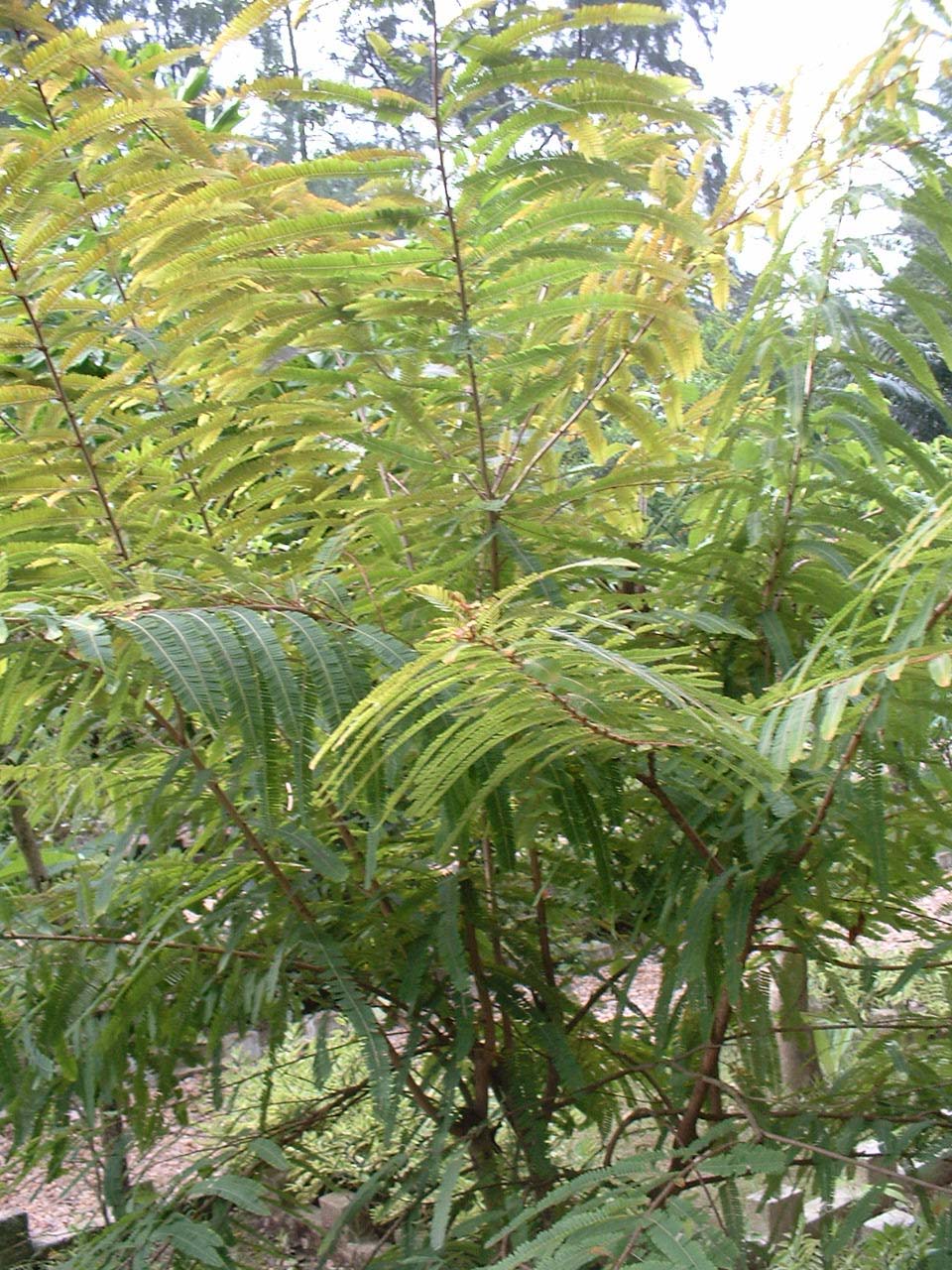
Read: Phyllanthus emblica L.
English name: Emblica myrobalan.
Sanskrit names: Adiphala, Amlaka, Amritaphala, Dhatri, Hatha, Nellikka.
Vernacular names: Asm : Amluki; Ben: Amla, Amlaki; Guj : Amali; Hin : Amla, Aon, Aonala; Kan : Amalaka; Mal: Amalakam, Nelli; Man: Heikru; Mar: Anvala; Mun : Meral daru; Orn : Amra; Ori : Amla; Pun: Ambli, Ambuli; Sad: Aonra; San: Aohal; Tam: Nelli, Toppunelli; Tel: Amlakamu, Usirika.
Trade name: Amla, Amlaki.
Traditional use: ETHNIC COMMUNITIES OF SAGAR DISTRICT (Madhya Pradesh) : Fruit: antiemitic, used in fever, indigestion; ETHNIC COMMUNIT/ES OF DEHRA DUN and SIWALIK DISTRICTS (Uttar Pradesh) : Fruit: in bronchitis, indigestion; Seed: in asthma; DANG (Gujarat) : Bark: on burn, wounds, stomach complaint; IRULAR (Tamil Nadu) : Leaf: against cold; BIRHoRE(West Bengal) : Fruit: in constipation, headache, liver complaint, madness; THANES (Uttar Pradesh) : Fruit: in constipation; ETHNIC COMMUNIT/ES OF GARHWAL : Fruit: laxative, cooling, in diabetes, dysentery, and as diuretic; ETHNIC COMMUNIES OF TIRAP (Arunachal Pradesh) : Fruit: in diabetes; NAGA: Fruit: in eye complaint; KHASI and JAINTIA : Fruit: in eye complaint; TRIBES OF MIRZA PUR DISTRICT (Uttar Pradesh) : Fruit: in eye complaint; TRIBES OF HAZARIBAGH DISTRICT (Bihar) : Fruit: used to revive taste; KOL (Uttar Pradesh): Fruit: on scorpion sting; ETHNIC COMMUNIT/ES OF MAYURBHANJ (Orissa) : Fruit: against thirst; ORAON : (i) Fruit: in cough; (ii) Juice of fresh fruit and (ii) Infusion of seed: in inflammation of eyes; (iv) Crushed fruit with fruit of Terminalia citrin a and Terminalia belerica macerated in a tumbler of water in the evening: a very good stomachic and tonic; MANIPURI: (i) Boiled extract of leaf: in controlling high blood sugar; (ij) Fruit: in constipation, bleeding gum, piles, blood diseases and also as brain and nerve tonic; SANTAL: (i) Leaf: in anaemia, diarrhoea, dysentery, fever, gravel, sores (agya ghao, rokoc ghao); (ii) Stem-bark: in cholera, profuse diarrhoea (haga sitka) , fistula, sores (bonga khoda, nason
ghao, pachiari ghao, palania ghao); (iii) Powder of male inflorescence: in nasal haemorrhage; (iv) Infusion of green fruit: in gripe; (v) Ripe fruit: in cystitis and diarrhoea.
RAJAN/GHANTU: it is acidic (amla) , astringent (kashaya) , pleasant(madhura), cooling and light, beneficial in burning sensation caused by deranged bile, vomiting, oedema and is rejuvenating; the fruit is appetising, antiemetic and removes fatigue, useful in constipation and flatulence.
AYURVEOA : Fruit is useful in acidity, urinary trouble, hiccup, vomiting, leucorrhoea, biliary colic, urticaria, conjunctivitis and dysentery.
SIOOHA : Root-bark, fruit-juice and dried fruit are used to prepare a medicine named Nelli.
Modern use: Fruit: pronounced expectorant, antioxidant, anticancerous; EtOH (50%) extract of fruit: antiviral, carminative, stomachic; Aqueous extract of fruit: increases cardiac glycogen level and decreases serum GOT, GPT and LDH in rats; Fruit-juice: (i) mixed with turmeric powder and honey: cures diabetes insipidus; (ii) in ghee: used for abdominal and glandular tumours; a constituent of the medicine SG-1-Switradilepa used against vitiligo, and of an antibiotic drug Septilin.
Phytography : Deciduous tree with flaky bark, greenish, grey or red; leaves distichously closely set, bipinnate, dark green, leaflets linear-oblong; flowers densely fascicled, yellowish, unisexual, males on slender pedicels while females subsessile; fruits light green when young, yellowish when mature, globose, depressed, succulent, obscurely six-lobed, one-seeded; seed trigonous.
Phenology: Flowering: February-May; Fruiting: May onwards.
Distribution: Common in the mixed deciduous forests of India, ascending up to 1500 m, often cultivated in gardens and homeyards; Bangladesh, Pakistan. Ecology and cultivation: Plant of tropical climate; predominantly wild, cultivated in Uttar Pradesh, Madhya Pradesh.
Chemical contents: Root: ellagic acid, oleanolic acid, oleanolic aldehyde, lupeol; Stem-bark: lelucodel-phinidin, procyanidin, 3-0-gallated prodelphinidin and tannin; Stem and Leaf: lupeol, β-sitosterol; Fruit: vitamin C, carotene, riboflavine, D-glucose, D-fructose, myoinositol, nicotinic acid, D-galacturoniaacid, phyllemblic acid, mucic acid, fatty acids, D-arabinosyl, D-xylosyl, L-rhamnosyl, D-glucosyl, D-mannosyl,
D-galactosyl. .
Remarks: Santals use bark in rinderpest, anthrax and convulsion of cattle. Fruits are eaten raw or as pickle and used to make ink. Wood is not attacked by insects.
Top Home
Euphorbia tirucalli L. (Euphorbiaceae)
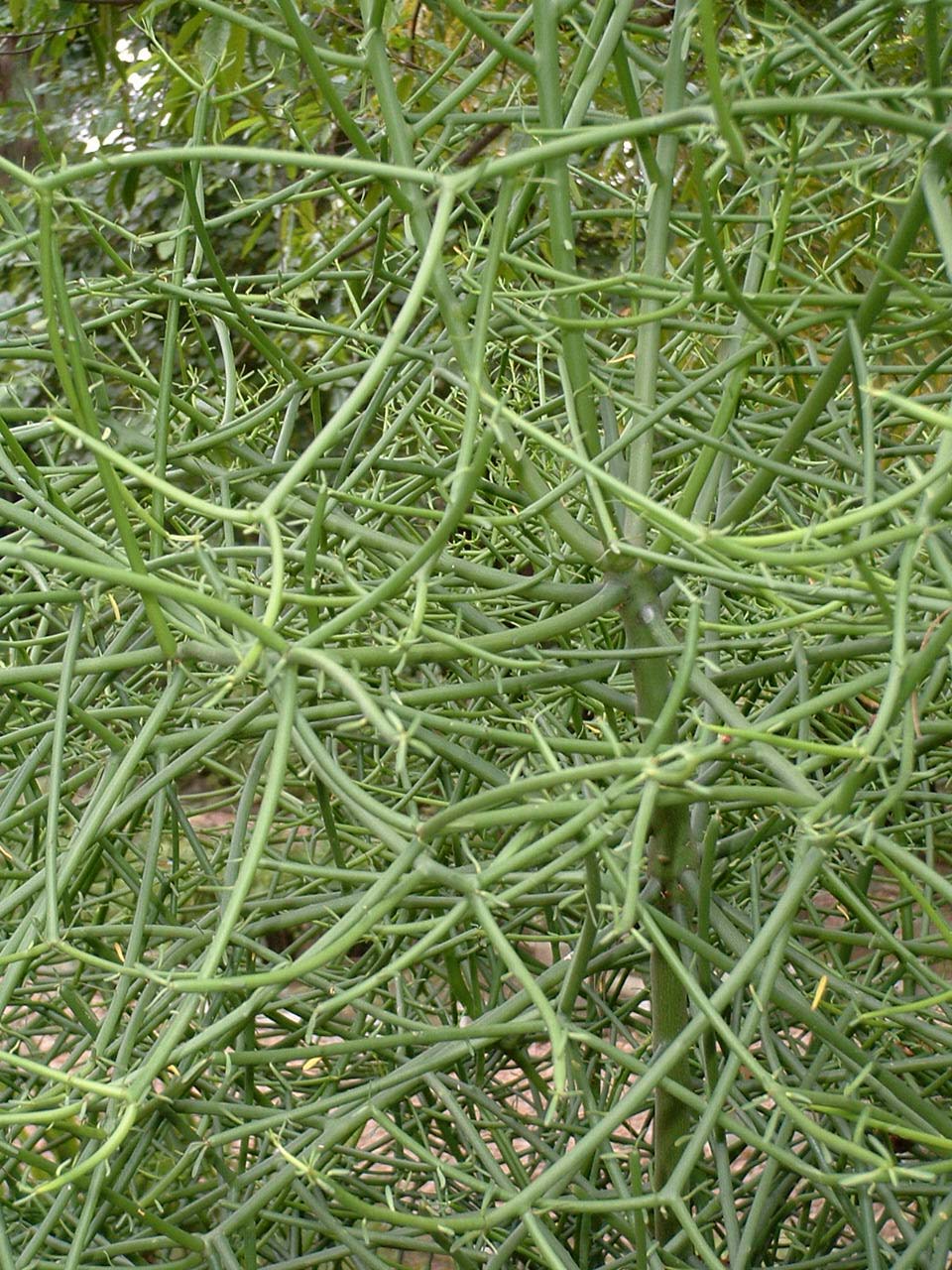
English name : Milk bush, Indian tree spurge.
Sanskrit names : Shatala, Trikantaka.
Vernacular names: Ben: Ganderi, Lankasij, Latadoona; Guj : Thor dandalio; Hin : Konpol, Sehund; Kan : Bantakalli; Mar: Shera; Tam: Tirukalli, Kalli; Tel: Chemudu.
Trade name: Tirukalli.
Traditional use: IRULAR: Latex: in body pain, eczema, scabies; ETHNIC COMMUNITIES OF CHAMPAKARAI and DHOOMANOOR (Tamil Nadu): Latex: on wounds; NAYADI : Latex: in rheumatism; ETHNIC COMMUNITIES OF MADHYA PRADESH: Latex: in earache, rheumatism, warts; ETHNIC COMMUNITIES OF CHHOTANAGPUR : Latex: in earache.
BHAVAPRAKASHA: Itis pungent, bitter, helps digestion, beneficial in oedema, deranged phlegm, epistasis, deranged bile, constipation and dyscrasia.
AYURVEDA : Root: beneficial in colic; Latex of stem and leaf: cures cough, earache, emetic, laxative and rubefacient.
Modern use: Stem-extract: antifungal; Aerial parts (50% EtOH extract) : antiprotozoal.
Phytography : Erect tree, 3-6 m high, branches thin, cylindrical, spreading, scattered, clustered, whorled, latex extraordinarily abundant, sticky and acrid; leaves alternate, linear, caducous, petioles modified to phylloclade; involucres clustered in the forks of branches, inconspicuous, flowers shortly pedicelled, bracteoles numerous; cocci dark brown, velvety, compressed; seeds ovoid, smooth.
Phenology: Flowering: very scarce, mainly in June-July; Fruiting: July-October.
Distribution: Introduced from tropical Africa, naturalised in the drier parts of India; elsewhere largely cultivated as hedges and fuel plants.
Ecology and cultivation: Xerophytic.
Chemical contents: Root: cycloartenol, euphorbol and its hexacosanoate, taraxerone, tinyatoxin; Bark: euphorbol and its hexacosanate, euphorginol=taraxer14-en-6-01, ingenol and its triacetate, taraxerone; Latex: a-amyrin, β-sitosterol, cycloartenol, cycloeuphordenol, 4-deoxyphorbol and its esters, euphol, euphorbinol, isoeuphorbol, palmitic acid, taraxerol, tinyatoxin, tirucallol, trimethyl ellagic acid; it may be noted that there are differences in chemical contents of latex of plant growing in differenet countries; Stem: campesterol, hentriacontane, hentriacontanol, kaempferol, stigmasterol, methyl ellagic acid.
Remark: The plant is worshipped as a sacred one.
Top
Ficus racemosa L. (Moraceae)
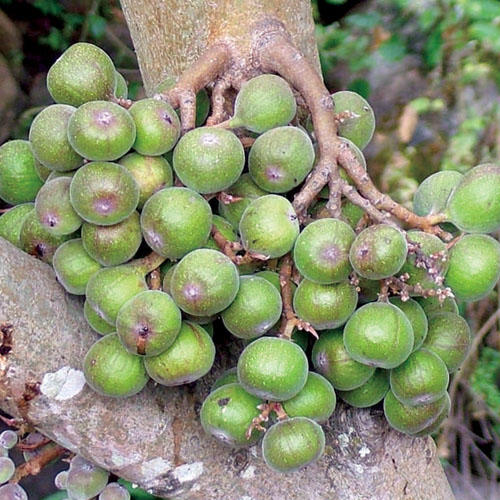
Syn : Ficus glomerata Roxb.
English names: Cluster fig, Country fig, Gular fig.
Sanskrit names: Apushpaphalasambandha, Audumbaram, Brahmavriksha, Haritaksha, Hemadugdha, Shetavalkala, Udumbara, Yajnaphala.
Vernacular names: Asm : Dimoree; Ben: Dumur, Jajna-dumur, Jaya dumur; Guj : Gudar, Umar, Umbara; Hin: Gulav, Umar; Kan: Atti; Mal: Atti, Athimaram; Man: Heibong; Mar: Umbar(a); Mun : Loa daru; Orn : Dumbari, Ori : Dimburi; Sad: Dumbair; San: Dumbari-hesa, Loa-dare; Tam: Atti, Aththi; Tel: Bodda, Paidi, Udumbaramu.
Trade name: Common fig.
Traditional use: MANIPURI : (i) Root-extract: in diabetes, dysentery; (ii) Latex: on boils; (Hi) Fruit: in pulmonary diseases; SANTAL : (i) Bark-juice: on boils, in adenitis axillaris, epidydimitis, hydrocele, orchitis; (ii) Latex: on adenitis, muscular pain, pimps, scabies; (iii) Juice of pith: in menorrahgia, spermatorrhoea; (iv) Warts on leaves: in small pOX; (v) Leaf gall (decoction) : for washing septic wounds; BHOXA : Latex: in piles; ETHNIC COMMUNITIES OF NORTHERN INDIA: (i) Latex: in piles, pulmonary diseases; (ii) Bark and Fruit (together) : in urinary complaints; (iii) Fruit: as carminative; GARHWALI: (i) Root: in dysentery; (ii) Bark: as astringent; ETHNIC COMMUNITIES OF MOUNT ABU (Rajasthan) : Leaf: in pneumonia; ETHNIC COMMUNITIES OF CHANDRAPURA (Maharashtra) : Leaf: in bronchitis; ETHNIC COMMUNITIESOFKHEDTALUKA(Maharashtra): (i) Barkand Fruit(together): in leprosy, urinary complaints; (ii) Fruit: in diabetes; ETHNIC COMMUNITIES OF CHHINDWARA (Madhya Pradesh) : (i) Latex: in diarrhoea; (ii) Fruit: as carminative; ETHNIC COMMUNITIES OF BANDA (Madhya Pradesh) : Latex: in dysentery, skin cracks in heels and lips.
RIGVEDA : cures piles, internal wounds, removes impurities from blood, worms from alimentary canal; YAJURVEDA : bark kills worms; ATHARVAVEDA: useful in skin diseases, including leprosy, sinus, oedema, impurities of blood and in piles; MADANADINIGHANTU : useful in antifertility, pimples and wounds; BHAVAPRAKASHA : useful in treatment of pimples and wounds; DHANVANTARINIGHANTU : removes worms, cures thrombophlebitis, syncope, burning sensation and unusual thirst; KAIYADEVANIGHANTU : astringent, sweet and heavy, cures pimples and wounds, diseases caused by deranged phlegm and deranged bile; fruits are tasteful, invigorating, astringent, cooling, cardiac tonic, useful in urinary diseases, bile disorders, menstrual disorders. .
AYURVEDA: Latex: external application useful in cuts, insect bites, boils, bruises, swellings, while internal application is beneficial in haemoptysis, bleeding piles and menstrual problems.
SIDDHA : (i) Bark: used to prepare the drug atti pattai, (ii) Latex: for atti pal, and (Hi) Leaf: an ingredient of atti ilai.
Modern use: Stem-bark (50% EtOH extract) : anti-inflammatory, anti protozoal, hypoglycaemic; Leaf-powder: useful in bilious affections; Leaf-gall: beneficial in small pox.
Phytography : Spreading laticiferous tree, 9.0-12.2 m tall, bark reddish grey, smooth; leaves alternate, stipules ovate-Ianceolate, pubescent, 1.25-2.5 cm long, petioles 2.5-5.0 cm long, lamina simple membranous, ovate to obovate-oblong or lanceolate, 10-18 cm long, dark green, glabrous or softly pubescent above while lower surface pubescent or glabrous; fruits borne in clusters on the main trunk and leafless short branches, subglobose or pyriform, 2.5-5.0 cm in diameter, red when ripe.
Phenology: Flowering: Spring; Fruiting: Rainy season.
Distribution: Throughout India; Pakistan, Bangladesh, Sri Lanka.
Ecology and cultivation: Tropical plant; grows on the banks of streams, sides of ravines, on rocky slopes, up to 1500 m; wild.
Chemical contents: Bark: ceryl behenati gluanol-OAc, lupeol and its α-OAc, β-amyrin, β-sitosterol; Leaf: β-amyrin, β-sitosterol, gluanol-OAc; Fruit: lupeol-OAc, gluanol-OAc, glucose, hentriacontane, β-sitosterol, a sterol, ester of taraxasterol, tiglic acid.
Remarks: Some ethnic communities of Rajasthan use leaves as a galactogogue for cattle. Rural folks of Bengal, Bihar and Orissa use bark in treatment of domestic animals. Unripe fruits are eaten as a vegetable by most of the Indians, while ripe fruits are consumed by Bhoxas, Garhwalis, tribes of North-East India, hill people of Maharashtra, tribes of eastern Rajasthan, Kerala and Madhya Pradesh (Bastar).
Tribes of Chhindwara (Madhya Pradesh) use young stem as toothbrush.
This tree is considered as a constituent of the sacred panchavata and as kalpataru by the Hindus. They keep a piece of stem of this plant, as a part of rite, in the labour room and also use the wood as samidh (sacrificial wood) in all yajnas.
The wood is also used by the Hindus to make effigy if the corpse is lost or not available.
Top Home
Gymnema sylvestre R. Br. ex Schult (Asclepiadaceae)

Syn : Periploca sylvestris Willd., Gymnema melicida Edgew.
English names: Vine, Periploca of the the woods.
Sanskrit names: Ajaballi, Ajagandini, Ajashringi, Bahalchakshu, Chakshurabahala, Grihadruma, Karnika, Kshinavartta, Madhunasini, Medhasingi, Meshashringi, Meshavishanika, Netaushadhi, Putrashringi, Sarpadanshtrika, Tiktadughdha, Vishani.
Vernacular names: Ben: Meshashringi; Guj : Dhuleti, Mardashing; Hin : Gurmar, Gumar, Merashinghi; Kan : Karhasige, Sannagera-shehumbr; Mal: Cakkarakkolli, Madhunashini; Mar: Kavali, Kalikardor, Vakundi; Tam: Adigam, Cheorukurinja, Kannuminayamkodi, Pasaani, Sakkaraikkolli, Shirukurinja, Sirukurumkay; Tel: Podapatra.
Trade names: Gurmar, Merasingi.
Traditional use: KOL : Leaf: in gastric troubles; ETHNIC COMMUNITIES OF RAJASTHAN and DHASAN VALLEY: Leaf: in diabetes; ETHNIC COMMUNITIES OF KANDALA (Maharashtra) : Leaf: in urinary complaints; GOND: Leaf: in diabetes, stomachache; ETHNIC COMMUNITIES OF MADHYA PRADESH: Leaf: in cornea opacity and other eye diseases; ETHNIC COMMUNITIES OF GODAVARI DISTRICT (Andhra Pradesh) : Leaf: in diabetes, glycosuria; IRULAR : Leaf: in diabetes; CHARAKA SAMHITA: removes bad odour from breast milk, aperitive; SUSHRUTA SAMHITA : plant useful as purgative, in eye troubles; leaf extract and also the same of flower beneficial for eyes; bark useful in the diseases caused by vitiated kapha (phlegm); BAGBHAT : rootbark useful in piles; BHAVAPRAKASHA: it is bitter, appetiser, gastric stimulant, removes cough, alleviates breathing troubles, useful in curing phlegm, eyetroubles, wounds; RAJA NIGHANTU : appetiser, removes phlegm, piles, colic pain, cures dropsy, useful in eye troubles, cardiotonic, beneficial in respiratory diseases, wounds, detoxicant; fruits are bitter, sialagogue, thermogenic, cures the diseases caused by vitiated kapha (phlegm) or vata (wind); NIGHANTU RATNAKARAM : removes cough, vitiated wind, detoxicant, appetiser, useful in eye troubles. AYURVEDA : acrid, alexipharmic, anodyne, anthelmintic, antipyretic, astringent, bitter, cardiotonic, digestive, diuretic, emetic,expectorant, laxative, stimulant, stomachic, uterine tonic; useful in amennorrhoea, asthma, bronchitis, cardiopathy, conjunctivitis, constipation, cough, dyspepsia, haemorroids, hepatosplenomegaly, inflammations, intermittant fever, jaundice and leucoderma; root emetic and removes phlegm; external application is useful in insectbite;
SIDDHA : an ingredient of 'Cirukuricinver'; UNANI : an ingredient of ‘Gurmarbuti’.
The fresh leaves, when chewed, paralyse the sense of sweet for sometime; for this reason it is called gur-mar, thereby meaning sugar-killer and impression has become prevalent in some parts of the country that it is useful in diabetes mellitus. Chewing fresh leaves also paralyse the taste of bitter for a while.
Modern use: Aerial parts (50% EtOH extract) : spasmolytic, hypyoglycaemic, in vitro antiviral against influenza A2 virus.
Phytography : Stout, woody, large climber; young branches slender and pubescent; leaves opposite, simple, petioles 0.6-1.2 cm, stout or slender, lamina 2.5-6.25 cm in length, elliptic or ovate, thinly coriaceous, upper surface rarely pubescent; cymes subglobose, ± 1.25 cm in diameter; flowers yellow, ±0.2 cm in diameter; follicles slender, ±5-7.5 by 0.8 cm; seeds pale brown, flat, ±1.25 cm long.
Phenology: Flowering: August-March; Fruiting: Winter.
Distribution: Mainly in Deccan peninsula, also found in Madhya Pradesh, Maharashtra, Rajasthan; Sri Lanka.
Ecology and Cultivation: Grows in the plains from the coast, in scrub jungles and in thickets; wild.
Chemical contents: Leaf: conduritol A, gymnestrogenin, gymnamine, hentriacontane, nonacosane, penta-OH-triterpene.
Remark: In Sri Lanka, plant used in bone fractures.
Top
Gmelina arborea Roxb. (Verbenaceae)

Syn : Premna arborea Roth
English names: Cashmeri tree, Coomb teak, Malay bush beech, White teak. Sanskrit names: Ashveta, Bahdraparni, Gambhari, Gandhari, Kakodumbari, Kassmari, Katphala, Nandivriksha, Sharubhadra, Shriparni, Subhadra, Vataha, Vidarini.
Vernacular names: Asm : Gomari; Ben: Gamar, Gamari, Gambar; Guj : Shewan; Hin: Gamari, Gambhari, Jugani chukur, Khambheri; Kan : Kashmirimara, Kumbalamara, Shivani; Lcd: Kashmar daru; Mal: Kambil, Kumil, Kumilu, Kumpil; Mar: Shewan; Mun : Kasambar daru, Kasmar daru; Orn : Gambhair; Ori : Bhodroparni, Gambari; Pun: Gumhar; Sad: Gambhair; San: Kashmar daru; Tam: Gumudu-taku, Kattanam, Kumadi, Kumala maram, Perumkumbil, Umithekku; Tel: Gumar-tek, Gummadi.
Trade names: Gamar, Gamari, Gumhar.
Traditional use: MIKIR: Root: as blood purifier, Leaf: as carminative; BIRHORE : Leaf: in headache; SANTAL : in anasarca, asthma, bronchitis, cholera, colic pain, diarrhoea, dropsy, dyspepsia, epilepsy, fever, phthisis, rheumatism, small pox, sore, spleen complaints, syphilis, throat swelling, urticaria, as antidote to snake bite and some other poisons; MUNDA : Bark: to cure wounds; SORA (Orissa) : Root: in catarrh of bladder; Decoction of root: as tonic; Bark: in stomach disorder; ETHNIC COMMUNITIES OF ARAKU VALLEY (Andhra Pradesh) : Root: in malarial fever; ETHNIC COMMUNITIES OF GODAVARI (Andhra Pradesh) : Bark-paste: on bone fracture, Leaf: in cough, gonorrhoea; ETHNIC COMMUNITIES OF DEHRA DUN (Uttar Pradesh): Leaf-paste: on wounds.
ATHARVAVEDA : blood purifier; CHARAKA SAMHITA : useful in vomiting, dropsy and in burning sensation of the body; SUSHRUTA SAMHITA : energiser like grape, can be used as substitute of sweet date palm; BHAVAPRAKASHA : it is bitter, appetiser, brain tonic, energiser, digestive, subdues vata and kapha, removes dropsy, alleviates thirst, useful in colic pain, burning sensation of body, fever, urinary complaints, wastage; RAJANIGHANTU : it is pungent, bitter, heavy (guru), thermogenic, removes oedema, phlegm, tridosha, burning sensation, fever, thirst, poisons; DHANVANTARINIGHANTU : bitter, thermogenic, removes bleeding tendency, tridosha, fatigue, burning sensation of body, fever, thirst; KAIYAOEVANIGHANTU : it is sweet, bitter, thermogenic, heavy, appetiser, digestive, brain tonic, removes dropsy, giddiness, colic pain, toxins, burning sensation of body, fever, alleviates thirst; flowers sweet, cooling, bitter, astringent, beneficial for the diseases caused by pitta and kapha; fruits unctuous, heavy, cooling, astringent, brain tonic, cardiotonic, removes giddiness, acidity, urinary troubles, burning sensation of body, wounds, wastage and troubles caused by vata; RAJAVALLABHAM: fruits seizing, bitter, sweet, heavy, cooling, good for hair, brain, removes burning sensation of body and diseases caused by pitta; roots are too hot; NIGHANTU RATNAKARAM: it is pungent, bitter, hot, astringent, heavy, sweet, appetiser, digestive, brain tonic, cardiotonic, removes thirst, colic pain, oedema, phlegm, toxins, burning sensation of body, fever, impurities of blood, piles, giddiness; fruits aphrodisiac, heavy, increases semen, cooling, unctuous, increases intelligence, removes urinary troubles, impurities of blood, thirst, burning sensation of body, good for urticaria, consumption, wounds, leucorrhoea.
AYURVEDA : Root: acrid, bitter, anthelmintic, galactogogue, laxative, stomachic, tonic, useful in burning sensation, dyspepsia, fever, haemorrhoids, hallucination, hyperdisia and stomachalgia; Bark: bitter, tonic, stomachic, useful in dyspepsia, fever; Leaf-paste: useful in cephalalgia, Leaf-extract: good wash for foul ulcer; Flower: acrid, astringent, bitter, refrigerant, sweet, useful in skin diseases including leprosy; Fruits: acrid, alterant, aphrodisiac, astringent, bitter, diuretic, refrigerant, sour, sweet, tonic, trichogenous, useful in anaemia, blood dysentery, constipation, leprosy, leucorrhoea, malnutrition of child and embryo, strangury and wounds.
Modern use: 50% EtOH extract of bark (and also of stem) : antiviral, hypoglycaemic. Phytography : Unarmed deciduous tree, 15-20 m in height; stem-bark whitish grey, lenticellate, young branches covered with fine white soft hairs; leaves .opposite, simple, petioles ±7.5 cm long, lamina broadly ovate, usually 22.5 by 15.0 cm, more or less acuminate, glabrous above but stellately hairy beneath; panicles terminal, often 30 cm long, many-flowered; flowers bucciniform, brownish yellow, ±3.7 cm long, tomentose at least when young; drupes ±1.8 cm 1000g, fleshy, ovoid, orange-yellow when ripe; seeds hard, oblong.
Phenology: Flowering: January-April; Fruiting: May-June. Distribution: Throughout India; Bangladesh (Chittagong), Sri Lanka. Ecology and cultivation: Grows in moist deciduous forests; wild.
Chemical contents: Root: ceryl alcohol, gmelofuran, gmelinol, hentriacontanol-I, n-octacosanol, β-sitosterol, sesquiterpene; Stem: arboreok, bromoisoarboreol, cluytyl ferulate, gmelanone, gmelinol, gummidiol, lignans, lignan hemiacetal, n-hentriacontanol-I, n-octacosanol, β-sitosterol; Leaf: apigenin, hentriacontanol, luteoHn, quercetin, quercetogenin, β-sitosterol.
Remarks: Ethnic communities of India use the plant in the treatment of rinderpest of cattle.
. In Sri Lanka, it is used in skeletal fracture.
It is one of the best and most reliable timber-yielding trees of India. The plant is a fast grower.
Top Home
Gloriosa superba L. (Liliaceae)

Syn : Methonica superba Lamk., Gloriosa simplex Don.
English names: Malabar glory lily, Glory lily.
Sanskrit names: Agninukhi, Agnisikha, Ailni, Garbhaghatini, Kalikari, Lanyli, Vishalya.
Vernacular names: Asm : Utatchandal; Ben: Bishalanguli, Ulatchandal; Guj : Dudhiovachnay, Varhvareli; Hin : Kalihari, Kaliari, Kulhari, Languli; Kan : Agnisikha, Akkatangaballi, Karadikanninagadde, Kolikuttuma, Sivasaktiballi, Mal: Kantal, Medoni, Mattamara, Mettonsi, Mentonni; Mar: Bachnag, Indai, Kariannag, Khadyanag, Nagharia, Nag karia; Mun : Bulung chukuru; Orn : Jhagrahi; Ori : Agnisikha, Garbhhoghhatono panjanyulia, Meherlaphulo, Panchaangula; Pun: Kariari, Mulim; Sad: Jhagar; San: Siricsamano; Tam: Akkinichilam, Kalappaikkilanku, Kalaippaikkishangu, Kannuvalikkodi, Nabhikkodi, Tel: Adabhinabhi, Agnisikha, Gangeri, Kalappagadda.
Traditional use: ETHNIC COMMUNITIES OF NORTH-EAST INDIA: Root: in gout, stomachache and as tonic; MUNDA AND ORAON: Tuber: for antifertility purpose; SANTAL : (i) Tuberous root: for abortion purpose, in intermittent fevers, wounds; (ii) Plant: in spleen complaints, syphilis, tumours; (ii) Leaf: in asthma; ETHNIC COMMUNITIES OF BIHAR: Root: in cholera, to facilitate childbirth; ETHNIC COMMUNITIES OF ORISSA: Tuber : as abortifacient; TRIBES OF VARANASI : Root: in gout; TRIBES OF PITHORAGARH: Tuber: in gonorrhoea, leprosy, piles; ETHNIC COMMUNITIES OF DEHRA DUN AND SIWALIK: Root: as anthelmintic; ETHNIC COMMUNITIES OF GARHWAL : Tuberous root: for abortion;
CHARAKA SAMHITA : useful in itching, skin diseases including wounds and ailments caused by vitiated kapha (phlegm) and vata (wind); SUSHRUTA SAMHITA: can be administered to a delivered mother along with spirituous drink to give relieve to her postnatal complaints, roots are poisonous; RAJANIGHANTU: it is pungent, thermogenic, eliminates deranged kapha (phlegm) and vata (wind), terminates pregnancy; DHANVANTARI NIGHANTU: in addition to the above, it is also useful in dropsy, labour pain, wounds, and as a purgative; MADANADI NIGHANTU : it is bitter, pungent, thermogenic, abortifacient, removes abdominal pain, expels the placenta, cures phlegm, skin diseases; BHAVAPRAKASHA : it is apperient, alkaline, astringent, pungent, bitter, highly potent, light, abortifacient, helps storing up energy, excites pitta (bile), it cures dropsy, piles, wounds, acute spasmodic pain, and removes worms; CHAKRADATTA : Root-paste: if smeared over' the palms and feet of a pregnant woman, delivery of child becomes easier.
AYURVEDA : (i) roots are abortifacient, acrid, alexiteric, anthelmintic, antipyretic, bitter, depurative, digestive, emetic, expectorant, gastrointestinal irritant, highly poisonous, purgative, rejuvenating, stomachic, thermogenic, tonic, beneficial in vitiated conditions of kapha (phlegm) and vata (wind), debility, dyspepsia, flatulence, haemorrhoids, helminthiasis, inflammations, in promoting labour pain and expulsion of the placenta; (ii) root-paste is effective against paralysis, rheumatism, snake bite, insect bites; (iii) leaf-juice effective against lice.
Modern use: Root (aq. extract) : ecbolic in humans and other animals; Plant (50% EtOH extract) : spasmolytic, Central Nervous System depressant; Leaf-juice: piscicide. Phytography : Herbaceous tendril climber; rootstock tuberous, naked; stem 3-6 m long, sparingly branched; leaves sessile or nearly so, opposite or 3-nately whorled, tip tendrillar; flowers axillary, solitary, nearly 10 cm, at first greenish, becoming yellow and finally scarlet or red; capsules nearly 5 cm long.
Phenology: Flowering: October; Fruiting: throughout the year.
Distribution: Throughout tropical India ascending up to 2000 m on the hills; Indo-China, Malaysia.
Ecology and cultivation: Plains from the coast on thickets; wild.
Chemical contents: Root: colchicine, b-sitosterol and its glucoside, band t-Iumicolchicine, 2-0H-6-MeO benzoic acid; Young leaf: cholidonic acid; Flower: luterlin and its glucosides, N-formyl-de-Ac-colchicine, lumicolchicine; Seed: colchicine.
Remarks: It is getting less attention in India, though extensive researches are on abroad.
Top
Ginkgo biloba L. (Ginkgoaceae)
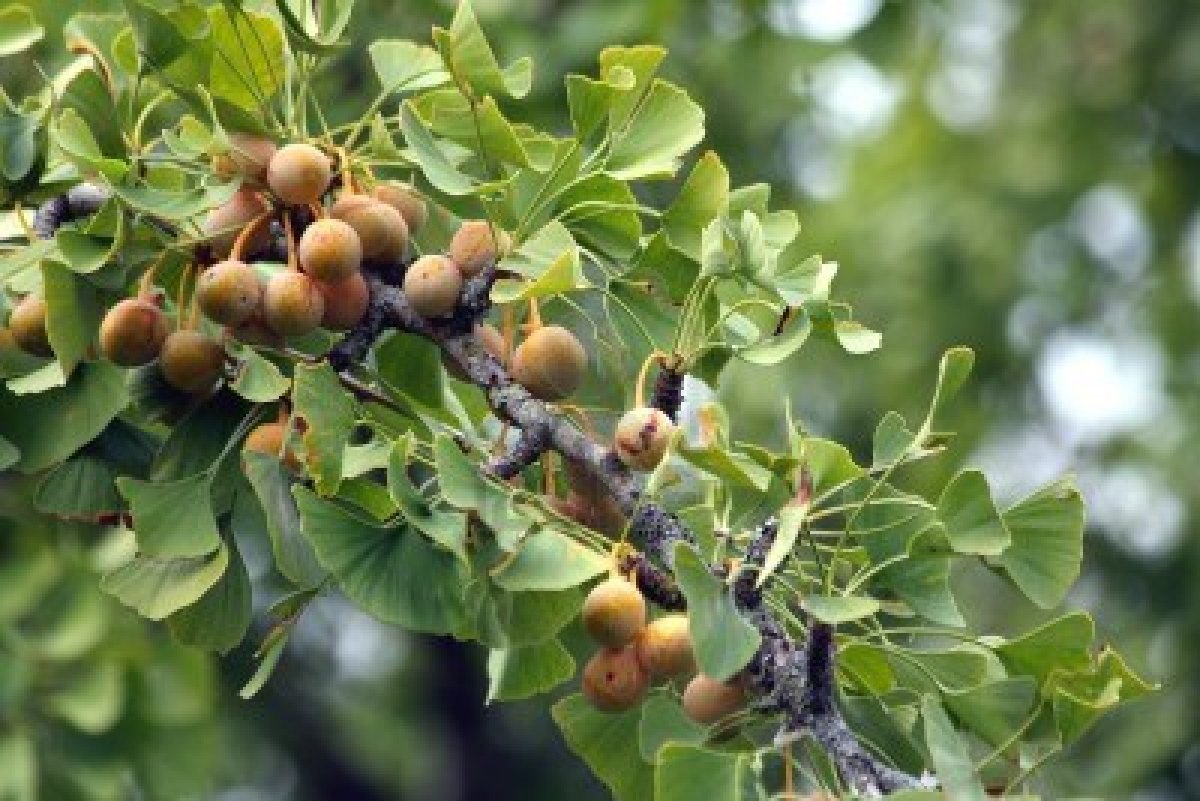
English name: Maiden hair tree.
Vernacular name: Hin : Balkuwari.
Trade name: Ginkgo.
Traditional use: Seeds: expectorant and sedative.
Modern use: Tanakan (active principle of plant extract) : effective in induced cerebral ischemia in rats; Tebonin (a preparation containing leaf extract) : used in cardiovascular disorders, increased cerebral blood circulation, Parkinson's disease; Nut (extract) : antibacterial against Mycobacterium smegmatis.
Recently Ginkgo is rapidly gaining recognition as a brain tonic that increases memory and boosts oxygen level in brain. It regulates neurotransmitters, increases blood flow and metabolism. It reduces migraine and vertigo. It may be useful in mental disorders, including Alzheimer's disease. Recently a pill containing extracts from Ginkgo has been launched for eliminating excess fat (cellulite) in women.
Phytography : Tree with pyramidal form, reaching a height of 30 m; leaves petiolar, lamina fan-shaped, bilobed; dioecious; mature seeds orange-coloured and are about the size of an apricot.
Phenology: Flowering and Fruiting: Summer.
Distribution: Darjeeling (West Bengal).
Ecology and cultivation: Native of China, cultivated in Indian gardens, particularly on hills.
Chemical contents: Root-bark: Ginkgolides A, B, C & M; Plant: bilobalide, bilobanone sesquiterpene; Leaf: flavonols, biflavonoids, diterpenes, sesquiterpene bilobalide A, β-sitosterol, ginkgolides A, B & C, shikimic acid, sequoyitol, 1,5-MeObilobetin; Fruit: anacardic acids, ginnol, bilobols, cardanols.
Remarks: Chinese consume Ginkgo seeds. Endosperm of roasted seed is edible and kernel is highly nutritious. It is believed that regular consumption of Ginkgo preparation staves of ravages of age and checks senility.Ginkgo is a contemporary of dinosaurs of the Jurassic period. Because of its primitive characters, it is known as living fossil. It is a native of Chekiang in East China. It is grown by the Buddhist monasteries of China and Japan as a sacred tree. The plant was introduced into Europe in early 18th Century and later in America. Only a few trees occur in India. Perhaps it does not exist in the wild today. Because of its nutritional and medicinal properties, it is receiving increased attention. Commercial cultivation of this species should be endeavoured in India. If appropriate measures for conservation of this important medicinal species are not taken, it is destined to be extinct in the near future.
Top
Garcinia xanthochymus Hook. f. ex T. Anders (Clusiaceae)
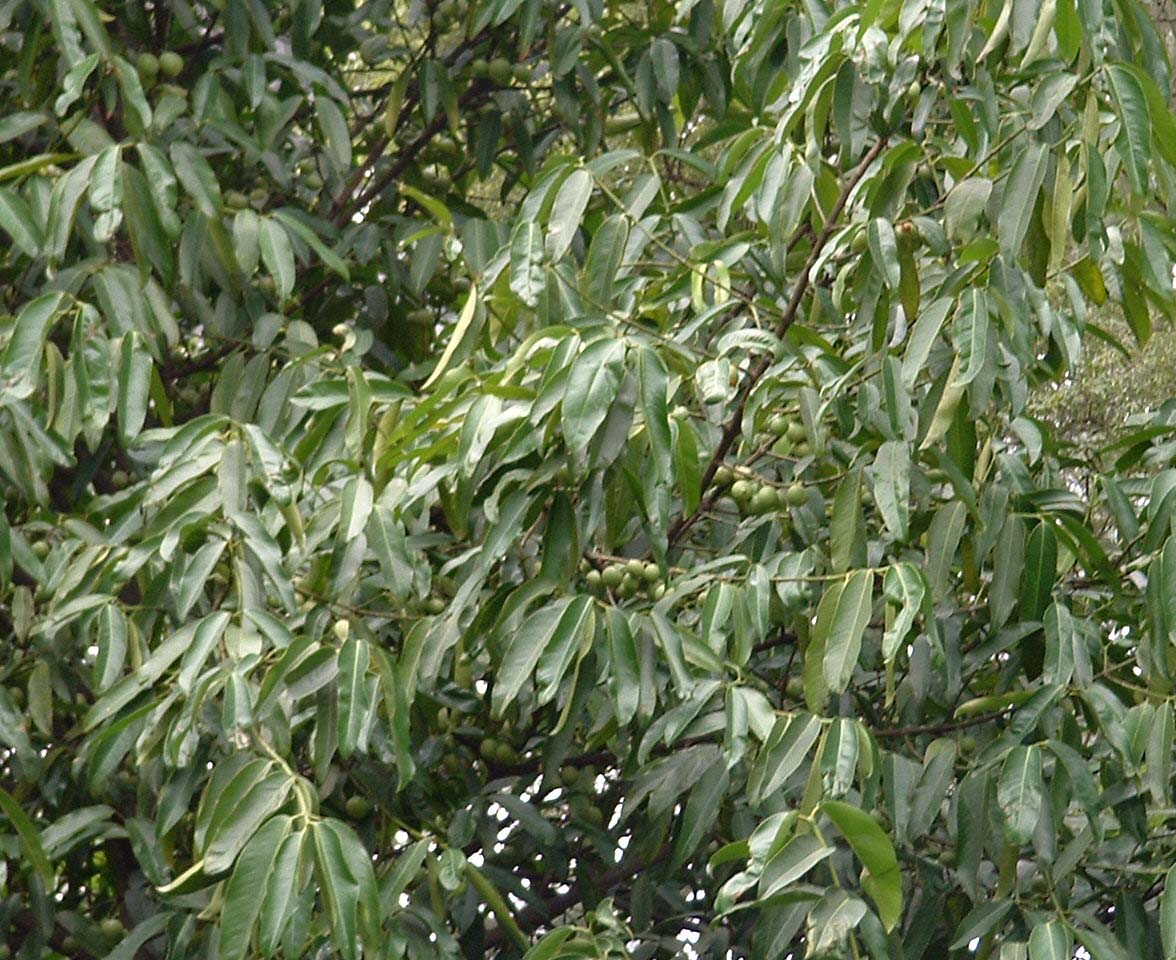
Syn : Xanthochymus tinctorius DC., Garcinia tinctoria Dunn.
English name: Egg tree.
Sanskrit names: Tamala, Tapinjha.
Vernacular names: Ben: Tamal, Chalta; Hin : Dampel, Tamal, Tumul; Guj : Kasamala, Ota; Kan:Deva-garige; Mal: Anavaya; Man: Heilbung; Mar: Jharambi, Dampel, Ota; Nep : Chunyel; Ori : Cheoro, Sitambu; Tam: Kulavi, Malaippachai, Mukki, Tamalam; Tel: Sitakamraku, Evarumidi, Tamalamu.
Trade name: Tamala.
Traditional use: Fruit: antiscorbutic, cooling, digestive, emollient, demulcent and cholagogue. Sherbet made from dried fruit is used in billiousness.
AYURVEOA : Young branch: paste as ointment on boils; Bark: astringent; Leaf: decoction useful in diarrhoea; Young leaves (roasted in a special method) : used in dysentery; Seed: butter made from seeds useful in pulmonary affections, dysentery, goitre.
Modern use: Xanthochymol : antibacterial against Streptococcus faecallis and Klebsiella pneumoniae.
Phytography : Evergreen tree, trunk straight; branches arising in tiers, drooping, angular; leaves opposite, coriaceous, bright green, shining, 22.5-45.0 cm by 5-10 cm; flowers polygamous, male flowers from axils of fallen leaves, fascicled with 4-8 flowers, white, thick, rough, hermaphrodites like male flowers, ovary ovoid, usually 5:chambered; fruits subglobose, pointed, dark yellow; seeds 1-4, oblong, yields a large quantity of gamboge.
Phenology: Flowering: Spring; Fruiting: Summer.
Distribution: Native to India and Myanmar; distributed widely in the lower hill forests of eastern Himalaya, Meghalaya, Sikkim, West Bengal, Maharashtra, Gujarat, Tamil Nadu, Kerala, Andhra Pradesh, the Andamans; Bangladesh, Myanmar.
Ecology and cultivation: Tropical forest; wild.
Chemical contents: Fruit: xanthochymol, isoxanthochymol, maclurin, euxanthone, 1,5-dihydroxy- and 1,3,5-trihydroxy-xanthones, methoxyxanthones, cambogin, volkensiflavone, morello-flavone, biflavones.
Remark: In South India, fruits of this species are used in lieu of tamarind.
Top Home
Holarrhena pubescence (Buch.-Ham.) Wall ex DC. (Apocynaceae)
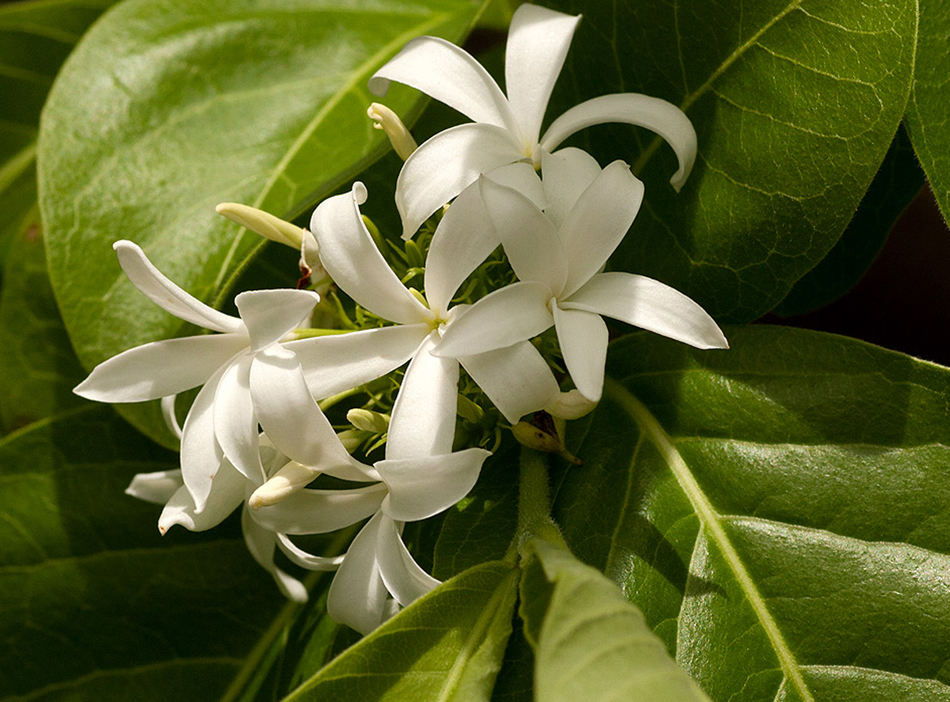
Syn : Holarrhena antidysenterica (L.) Wall., Echites pubescens Buch.-Ham.
English names: Bitter oleander, Conessi bark, Dysentery rosebay, Easter tree, Ivory tree, Tellichery bark.
Sanskrit names: Girimallika, Indrayava, Kalinga(ka), Kalingyava, Katuka, Katuja, Mahagandha, Mallikapushpa, Panduradruama, Pravrishya, Sangrahi, Shakrapadapa, Vatsika, Vrikshaka, Yavaphala.
Vernacular names: Asm : Dhurkhuri, Ducikhuri; Ben: Kurchi, Katuraj, Kuteswar, Indrajava; Guj : Dhowda, Kuda, Kari; Hin : Kurchi, Karchi, Karra; Kan : Beppale coodsaloo, Korchie; Lep : Fajeerip; Mal: Kodagapala; Mar: Kura, Kala-kura, Kear, Kewar, Kodago, Kuda, Dola-kuda, Pandhrakura;'Mun : Ludu-ba, Toa-ba; Nep : Khuria; Ori : Kherwa, Pita, Korwa, Patru kurwa; Orn : Koraia; Pun: Kawar, Kura, Kear, Kewar; Sad: Koraia; San: Hat; Tam: Kuda-sappalai, Veppalei, Kodagapalei, Indrabam; Tel: Kodisepala, Palakodsa, Pala, Kodaga.
Trade name: Kurchi.
Traditional use: MANIPURI : Bark (boiled extract) : in diarrhoea, dysentery; GARO : Bark and Leaf: in dysentery; ETHNIC COMMUNITIES AROUND GUAHATI: Seed: as anthelmintic; BODO (of Assam) : Bark: in diarrhoea, dysentery, piles; Flower: as appetiser and in intestinal worms; Seed.. in leprosy; ASUR (of Bihar) : Bark: in snake bite; Seed: diarrhoea, fever, intestinal worms; MUNDA : Root and Leaf: in diarrhoea, bleeding from nose, haemorrhage after childbirth; SANTAL : Root: in bite of dog or jackal, blood and mucous in bowel excretion, diarrhoea, dysentery, hematuria, spermatorrhoea, spleen complaints; Bark.. in bronchitis, chameleon's bite, cholera, cold, colic, fever, menorrhagia; Fruit: in anaemia, colic, constip5ltion, diarrhoea, dry cough, epilepsy, gravel, postnatal complaints, stomachache; TRIBAL SOCIETIES OF HAZARIBAGH AND RANCHI : Bark: in gastric disorder, to revive taste in tongue; ETHNIC COMMUNITIES OF ORISSA: Latex: in eczema and other skin diseases; ETHNIC COMMUNITIES OF ABUJH-MARH (Madhya Pradesh) : Bark: in menstrual complaints; TRIBAL COMMUNITIES OF SAGAR (Madhya Pradesh) : Seed: in dysentery; THARU (of Uttar Pradesh) : Bark: in fever; Bark and Seed (together) : in dysentery; KOL (of Uttar Pradesh) : Seed: in digestive complaints; ETHNIC COMMUNITIES OF DEHRA DUN AND SIWALIK: Seed: in diarrhoea, dysentery, fever; ETHNIC COMMUNITIES OF EAST RAJASTHAN: Bark and Seed (together) : in dysentery; ETHNIC COMMUNITIES OF MOUNT ABU: Bark: as antidote to snake bite; DANG: (of Gujarat ): Bark: in diarrhoea; VASAVA (of Gujarat ) : Root: in fever; Root and Bark (together) : in gout; ETHNIC COMMUNITIES OF SAURASHTRA: Bark: in bronchitis; ETHNIC COMMUNITIES OF DAHANU FOREST DIVISION (Maharashtra) : Bark and Leaf (together) : in dysentery; Latex: as antidote to snake bite, Seed: in asthma, colic.
ATHARVAVEDA : increases semen, tightens the slackened muscles; CHARAKA SAMHITA : Bark (paste) : good for skin diseases, leprosy, ringworm, piles, fistula, adenitis; Fruit: in vomiting, beneficial in disorders caused by vitiated phlegm and bile, as galactagogue; Seed: in piles; SUSHRUTA SAMHITA: Flower: beneficial in deranged phlegm and bile, and a good remedy for leprosy; CHAKRADATTA: Bark: in diarrhoea; BHAVAPRAKASHA: pungent, drying, refrigerant, excitant, cures piles, diarrhoea, phlegm, bile, leprosy, alleviates thirst; RAJANIGHANTU : pungent, bitter, thermogenic, astringent, cures diarrhoea, vitiated bile, skin diseases and piles; DHANVANTARINIGHANTU: pungent, bitter, astringent, drying, cooling, cures skin diseases, gastroenteritis, vitiated bile; MADANANIGHANTU : excitant, digestive, astringent, beneficial in bleeding tendency, worms, skin diseases; SALIGRAMNIGHANTU : appetising, beneficial in vitiated phlegm, cures diarrhoea, skin diseases, worms; KAIYADEVANIGHANTU : astringent, cooling, drying, excitant, pungent, beneficial in vitiated phlegm, bile, skin diseases, diarrhoea, piles; Flower: refrigerant, bitter, astringent, excitant.
AYURVEDA: Bark and Seed: acrid, anthelmintic, antiperiodic, aphrodisiac, astringent, bitter, carminative, expectorant, febrifuge, stimulating, beneficial in asthma, bronchitis! blood dysentery, diarrhoea, dropsy, dysentery, fever, haemorrhages, haemorrhoides, hepatopathy, malaria, piles, rheumatism, skin diseases, urinary troubles, verminosis, vomiting; Leaf: useful in boils, bronchitis, dysentery and wounds.
SIDDHA: Root and Bark: used as constituents for the preparation of Kutacap patai.
UNANI : in the preparation of Sufuf Habis and Majnum Bawasir.
Modern use: Bark (50% EtOH extract) : hypotensive; Bark-powder: in abdominal and glandular tumours; Fruit (50% EtOH extract) : anticancer, anti protozoa, hypoglycaemic, astringent, febrifuge, useful in diarrhoea, intestinal worms, and to regulate menstruation.
Phytography : Deciduous tree or large shrub; leaves sessile or subsessile, broadly ovate to elliptic-oblong, abruptly acuminate, often unequal, rounded or obtuse at base, lateral nerves 10-15 pairs, arching near the margin; flowers white, bracts small, follicles 20-42 by 0.8-1.2 cm; seeds up to 1 cm long, linear-oblong, coma about twice as long as seeds, seeds brown.
Phenology: Flowering and Fruiting: May-January.
Distribution: Major parts of India up to 1500 m in the Himalaya; Bangladesh, also in Africa-mostly in drier regions.
Ecology and cultivation: Common in village surroundings; sometimes in private gardens. Chemical contents: Root-bark: holacetine; Stem-bark: L-quebrachitol, dihydroisoconessimine, kurcholessine, 3-a-aminoconan-5-ene, 7-a-OH-conessine, holonamine; Leaf: aminoglycosteroids, aminode-oxyglycosteroids, kurchiphylline, kurchiphyllamine, kurchaline, holadysine, holadysamine, holantosines A, B, C & D, holarosine A, B, E & F.
Remarks: Tribals of East Rajasthan give root to cattle in a disease in which tongue ejects out and gets swollen. Tribals of Maharashtra eat flower and seed as vegetables. Ethnic communities of Ratan Mahal Hills use latex to curdle milk. Santal women use flowers to decorate their hairdos. Tribals of Madhya Pradesh use wood to make combs and many household articles.
Top Home